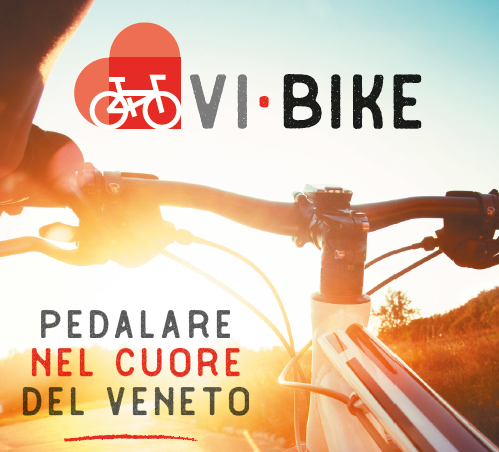
You can choose to visit the museums with COMBINED CARDS, the Vicenza Card (11 sites) or the 4 Museums Card, or with single museum tickets.
The Vicenza Card is valid for 8 days from the day of issue and it gives access to 11 sights (one access for each site):
Teatro Olimpico, Civic Art Gallery of Palazzo Chiericati, Natural History and Archaeological Museum, Risorgimento and Resistance Museum, Santa Corona Church, Diocesan Museum, Palladio Museum, Gallerie d'Italia - Palazzo Leoni Montanari, Basilica Palladiana (exhibitions excluded), Jewellery Museum and the Galleries of Palazzo Thiene.
The 4 Museums Card is valid for 8 days from the day of issue and grants the access to 4 sites of your choosing from the ones included in the museum network.
You can buy the cards in the following offices: Tourist information office IAT (next to the entrance of the Teatro Olimpico) - Gallerie d’Italia Palazzo Leoni Montanari - Palladio Museum - Diocesan Musem - Jewellery Museum - Basilica Palladiana.
The museums are always closed on Monday.
2024: CHECK THE UPDATED OPENING TIMES HERE
For further clarifications, please send an email to This email address is being protected from spambots. You need JavaScript enabled to view it. or call +39 0444 964380
DISCOVER MORE ON THE LOCAL MUSEUMS
DOWNLOAD THE BROCHURE "VICENZA, GIOIELLO DEL RINASCIMENTO"
SUGGESTED WALKING ITINERARIES
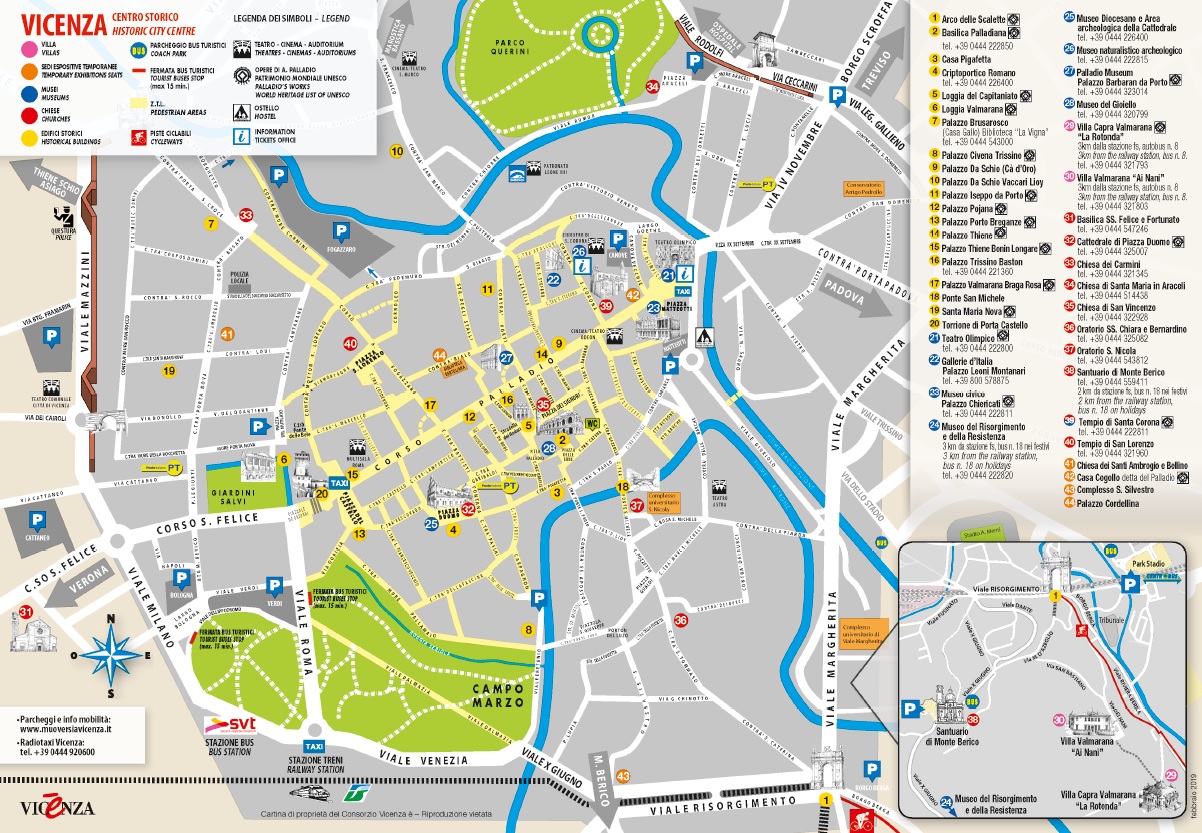
Download the map here
Making a journey to Vicenza means to establish a contact with the history of architecture. Romanic, Gothic, Renaissance, Baroque and Neo-classicism scenes decorate the infinite perspectives of the so-called "theatre-city".
The Teatro Olimpico
Piazza Matteotti 11 - Tel. 0444 964380
www.teatrolimpicovicenza.it This email address is being protected from spambots. You need JavaScript enabled to view it.
It is one of the artistic wonders of Vicenza. During the Renaissance, in fact, a theatre was not a building in itself, as it would later become, but a temporary arrangement of an outside space or an existing building; in Vicenza, these spaces were courtyards of palaces or the hall of the Palazzo della Ragione. In 1580, at the age of 72, Palladio was commissioned a permanent theatre by the Accademia Olimpica, the cultural group he belonged to himself. The design is clearly inspired by the Roman theatres, as described by Vitruvius: an elliptical terraced auditorium, framed by a colonnade, with a frieze topped by statues. In front of it is the rectangular stage and a majestic proscenium with two orders of architecture, opened by three arcades and divided by half-columns inside which we find aedicules and niches with statues and panels with bas-reliefs. Critics call the work “manneristic” because of the intense light and shade effect, which is also intensified by a series of other optic solutions the architect used thanks to his experience: the progressive diminishing of the fronts with height is visually compensated with the protruding statues; he plays with overhangs and niches to increase the sense of depth.
Palladio’s design was made a few months before his death and he would not see the result; his son Silla oversaw the works and handed the theatre over to the town in 1583. The first performance on Carnival 1585 was memorable; its subject was a Greek tragedy, Oedipus the King by Sophocles, and the stage design reproduces the seven streets of the city of Thebes, which can be seen in the five openings of the proscenium through a clever game of perspectives. The creator of this little wonder inside the wonder is Vincenzo Scamozzi. The effect was so impressing, the wooden structures became a stable part of the theatre. Scamozzi was also asked to create accessory spaces: the “Odeo”, the hall where the meetings of the Accademia took place, and the “Antiodeo”, decorated with monochrome panels by the fine Vicenza painter Francesco Maffei.

The Basilica palladiana
The most significant building is the Basilica, the core of which is the ancient Palazzo della Ragione of the Late Gothic period, with its loggias built byAndrea Palladio starting from 1546. At the ground floor we find some goldsmiths’ shops, which keep the historical vocation for trade of the town alive, as well as some venues for exhibitions.
A marble staircase of the late fifteenth century leads up to the upper loggia, from which we reach the hall with the characteristic copper roof, shaped like an inverted hull of a vessel. The picture of the Basilica is completed with the Torre di Piazza bell tower, also called Torre Bissara because it was erected on a defence structure of the powerful Bissara family. It is 82 metres high, with a square base of seven metres and a considerable inclination. The basilica, a prime example of Palladio’s architecture, stands in the most representative place in town, which embraced the great architect and saw him grow: the Piazza dei Signori, the former Roman Forum and the Medieval public place. The building we are talking about is the so-called Palazzo della Ragione, the ancient seat of the civil authorities. At the end of the 15th century it was decided to surround the original Gothic building with a double order of loggias, to embellish its image. This first initiative went wrong in the worst of ways, with a collapse after only two years after the inauguration, and some more forty years were needed for the Town Council to make up for the embarrassment. On the list of architectural counsellors were Sansovino (1538), Serlio (1539), Sanmicheli (1541) and Giulio Romano (1542). As it sometimes happened with too controversial issues, an inside solution prevails: Andrea Palladio, the young architect grown in the shadow of the humanist Gian Giorgio Trissino, who with his important contacts played a crucial role in submitting Palladio’s name to the Town Council. It is actually Palladio who gives the building a name true to his beliefs: Basilica, like the place in ancient Rome where politics and the most important businesses were run. At the age of 38 Palladio gets his first public commission, which, besides the generous and prolonged payment (5 ducats per month for the rest of his life), makes him officially the architect of Vicenza.
To put his plans into practice, however, he has to wait for three years more, until 1549, until the city’s government’s doubts are dispelled. Palladio’s design is based on the repetition of the Serlian window, made of an arch with a constant size flanked by two rectangular openings of variable size, thus able to absorb the different sizes of the bays, most of all at the corners of the building (this scheme was named after Sebastiano Serlio, who published it in a treatise on architecture in 1537). The material used was white stone from Piovene Rocchette, a place at the foot of the Asiago high plateau; it was a unique event because the quarry was completely emptied for this purpose. The cost of the building was exceptionally high: 60,000 ducats, apportioned over 65 years, because the works ended in 1614, 34 years after the architect’s death. As for the later events regarding the Basilica, we must remember the effects of the bombings during World War II, which demolished the building.
During the last 50 years the Basilica was used for shows and sport events, namely basketball games, when the female teams of Vicenza lead the national championship in the 1960es-70es. In recent years it has mostly been used for exhibitions, apart from the goldsmiths’ shops at the ground floor. In 2007 and 2008 important renovation and reinforcement works were carried out, which implied, among other things, the rebuilding of the arches that support the famous vault. The museum dedicated to the Jewellery was opened in 2010.
The piece of architecture which adds dignity to the Piazza is the Palazzo Chiericati, of 1550, the year Palladio gave the designs to Girolamo Chiericati. It is the most spectacular civilian residence designed by Palladio, today seat of the Vicenza Town Museum. It was purchased in 1838-39, then renovated and finally turned into a museum and opened in 1855.
The museum presents itself as one of the greatest art collections of the Veneto, with some of the most important works. Especially the picture gallery offers an overview of the art scenario of the sixteenth century, useful to explain the relationship between figurative arts and the architecture of the time. Particularly interesting are, first of all, the painters of the so called “School of Vicenza” of the Renaissance: the founder Bartolomeo Montagna, Giovanni Buonconsiglio, Marcello Fogolino and Giovanni Speranza. As for the sixteenth century, we have a remarkable work by Paolo Veronese, Palladio’s favourite artist: “Madonna and Child with Saint Peter and Saint Agnes”, but also works by Vittoria, Fasolo, Maganza and others of Palladio’s periodic collaborators. The survey goes on up to Tiepolo, showing also the followers of Palladian architecture.
In the Department of Prints and Drawings sketches and designs signed by Palladio, Scamozzi and are kept.
It is worth remembering that in front of the Palazzo Chiericati Palladio also built the Palazzo Piovene in 1569, exactly where the river Bacchiglione flows into the river Retrone; it was a contribution to right up the harbour area which Palladio supported warmly. The palace was demolished to build the town slaughterhouse.

Civic Art Gallery of Palazzo Chiericati
Piazza Matteotti, 37/39 - Tel. 0444 222811
This email address is being protected from spambots. You need JavaScript enabled to view it. www.museicivicivicenza.it
It is the most spectacular civilian residence designed by Palladio, today seat of the Vicenza Town Museum. The museum presents itself as one of the greatest art collections of the Veneto, with some of the most important works. Especially the picture gallery offers an overview of the art scenario of the sixteenth century, useful to explain the relationship between figurative arts and the architecture of the time. Particularly interesting are, first of all, the painters of the so called “School of Vicenza” of the Renaissance: the founder Bartolomeo Montagna, Giovanni Buonconsiglio, Marcello Fogolino and Giovanni Speranza. As for the sixteenth century, we have a remarkable work by Paolo Veronese, Palladio’s favourite artist: “Madonna and Child with Saint Peter and Saint Agnes”, but also works by Vittoria, Fasolo, Maganza and others of Palladio’s periodic collaborators. The survey goes on up to Tiepolo, showing also the followers of Palladian architecture.
In the Department of Prints and Drawings sketches and designs signed by Palladio, Scamozzi and Calderari are kept.
DOWNLOAD THE FOLDER

Natural History and Archaeological Museum
Contra' S. Corona, 4 - Tel. 0444 222815
This email address is being protected from spambots. You need JavaScript enabled to view it. www.museicivicivicenza.it
The Natural History and Archaeological Museum, housed since 1991 in the area of the cloisters of Santa Corona, is divided into two sections: Naturalistic and Archaeological. The first is devoted to the illustration of the characteristics of the territory, especially that of Berici, while the second one collects the most significant archeological aspects of Vicenza and its province.

Risorgimento and Resistance Museum
Viale X Giugno, 115 - Tel. 0444 222820
This email address is being protected from spambots. You need JavaScript enabled to view it. www.museicivicivicenza.it
Free entrance to the public
The Ambellicopoli hill, the site of the museum’s Villa Guiccioli premises, was where the heroic resistance of 1848 took place. The people of Vicenza defended the city from here. The mementoes in the collections provide interesting evidence of historic events from the time of Napoleon’s first Italian campaign in 1796 to the end of the Second World War and the fight for liberation (1945). This one and a half century period transformed the political, social, economic and moral nature of Italy and Europe several times.

Palladio Museum
Contrà Porti, 11 - Tel. 0444 323014
This email address is being protected from spambots. You need JavaScript enabled to view it. www.palladiomuseum.org
Palazzo Barbarano, one of the most beautiful Palladian urban dwellings, houses the Palladio Museum that accompanies the visitors on an emotional tour inside AndreaPalladio’s life and time, to discover Palladio’s masterpieces in Veneto region. Designed in 1569 by Andrea Palladio in the mannerist style that was typical for his late period. The façade has nine bays, richly decorated with festoons. It was commissioned by Montano Barbaran, who had the same great plans as Palladio’s other noble clients, and put a central plot of land at the architect’s disposal, with the task of blending the buildings on the plot to one palace worth of his ambitions.
The first thing we notice is that the atrium is out of centre, a forced solution (the client had purchased another building at an advanced state), but this does not alter the serenity of the work. The view at the entrance is very impressive: a series of Serlian windows is implemented, to support the upper hall with a cross vault and to compensate the different existing walls with flat planks. Actually, the Palazzo Barbaran is the only palace in Vicenza which was finished according to the design. Among other things, it is the building with the most important purpose: it is seat to the international centre for architecture studies “Andrea Palladio” (Cisa) and the Palladio Museum.

Galleries of Palazzo Leoni Montanari
Contrà S.Corona, 25 - Tel. +39 800.167619 This email address is being protected from spambots. You need JavaScript enabled to view it. www.gallerieditalia.com
This important Baroque palazzo rises in the final stretch of the Contrà Santa Corona. It was commissioned in 1623 by a family of rich wool and silk traders. It reveals very suggestive interiors, like the spectacular Loggia d’Ercole or the frescoed gallery “Galleria della Verità”.
It houses three permanent art collections belonging to the Bank: the first floor exhibits nuclei of vases, selected from the large Attican and Magna Graecia pottery collection, splendidly decorated with painted images. The same floor houses eighteenth-century Venetian paintings, from the ironic custom scenes by Pietro Longhi to the airy paintings by the “vedutisti” , who depicted the natural and architectural splendours of Venice and other cities. The second floor is dedicated to Russian icons, which take the visitor through a historic, artistic and spiritual route with the strength of their colours and fidelity to the antique models.

Diocesan Museum
Piazza Duomo, 12 - Tel. 0444 226400
This email address is being protected from spambots. You need JavaScript enabled to view it. www.museodiocesanovicenza.it
The residence of the bishop of Vicenza is a sober Palladian building of the beginning of the nineteenth century, rebuilt after its destruction during the Second World War, faithful to the original. Remarkable features are the stylistic details taken from Palladio (intersected semi-columns that mark the main body between the side bodies) and from Scamozzi (the combination of semi-column and corner pillar at the ends.
The building has a four-arch porch, above which there are eight windows, with windowsills and parapets made of finely decorated Nanto stone. The museum houses a collection of memorabilia of ancient Christianity, of the Church of the High and Early Middle Ages, as well as a collection of sacred vestments, sacred jewellery and religious paintings from the fourteenth to the eighteenth centuries. It features an extraordinary ethnographic section with artefacts from all continents and an exceptional collection of round shaped minerals. In the basement there is the archaeological area with remains of a tower of the high Middle Ages.

Church of Santa Corona
Contrà S. Corona - Tel. 0444 222811
This email address is being protected from spambots. You need JavaScript enabled to view it. www.museicivicivicenza.it
Free guided tours in Italian and English are available for smartphone and tablet users.
Magnificent Dominican Church in the form of a Latin cross was founded by the Dominicans to preserve the relic of the Holy Thorn, donated by the king of France Louis IX in 1259 to the bishop Bartolomeo da Breganze. It is presented to the public on Good Friday. Palladio was buried in this church in 1580; in mid- 19th century his remains were moved to the Temple of Fame at the Cimitero Maggiore, where the famous people of Vicenza rest. The interior is austere and solemn, with three bays and a presbytery designed in 1480 by Lorenzo da Bologna.
The Valmarana Chapel was designed by Palladio in 1567 but a very remarkable thing is the church’s artistic heritage: in the third chapel on the right, the Adoration of the Magi by Paolo Veronese, of 1573; in the chapel at the back of the right bay, The Saints Peter and Paul and Pius V Worship Mary, a work of art by the early Venetian Giovanni Battista Pittoni of 1723; the greater altar of 1669 with marble marquetry by the Florentine Francesco Antonio Corberelli; the fifth altar of the left bay shows The Baptism of Christ, a masterpiece of the late Venetian artist Giovanni Bellini (1427-1516). The whole surface of the grand complex of the high altar is covered with inlays of polychrome marble, pieces of lapis lazuli, corals, carnelians and mother-of-pearl.
The Dominicans were driven out in 1810, following Napoleon’s suppression, and the church became propriety of the town council. Today the adjacent monastery is the seat of the Museum for Archaeology and Natural Sciences.

Jewellery Museum
Palladian Basilica, ground floor Piazza dei Signori, 44 - Tel. +39 0444 320799
This email address is being protected from spambots. You need JavaScript enabled to view it. www.museodelgioiello.it
The first one in Europe and one of the few museums in the world exclusively dedicated to jewellery and the art of the goldsmith. The Jewellery Museum, a permanent museum space located in the Basilica Palladiana, is a Fiera di Vicenza project created in partnership with Comune di Vicenza. The Museum offers an unusual aesthetic experience in exploring jewellery, and promotes a very ancient object that is deeply rooted in human culture. Curated and directed by Alba Cappellieri, Professor of Jewellery Design at Milan Polytechnic and the main scholar of jewellery in Italy, presents the visitor with a scientific and educational trail set out on two levels. The innovative staging, designed by the international designer Patricia Urquiola, and the coexistence with the Palladian Basilica donate to the Museum a high artistic value. The curatorial choices have a very strong impact, and aim to reinstate the semantic complexity of jewellery from very disparate viewpoints, introducing the visitor to an awareness of different values and contents and, at the same time, of Vicenza as an authoritative cultural centre of jewellery.

The Galleries of Palazzo Thiene
Contrà S. Gaetano Thiene, 11 - Tel. 0444 320854
The palace stands on the Contrà San Gaetano Thiene, one of the central side roads of the Corso Palladio, in the part of the town opposite the Piazza dei Signori. The year before he went to see Rome with his mentor, the conte Gian Giorgio Trissino, who had a great influence on his architectural culture. Thus, it can hardly be a coincidence that his clients, the Thiene brothers from one of the most powerful families of Vicenza, are sophisticated people who are in contact with the highest ranking people in culture. The Thiene family had considered taking up an entire block in the historic town centre, with a view on the Corso, and involved one of the most famous architects at that time, Giulio Romano (1492-1546), who mostly worked for the Gonzagas in Mantua, but was in Vicenza in 1542 for advice on the Basilica and very likely to hand in a rough design of the Palazzo Thiene. When he died prematurely, Palladio, the rising architect, was now fit to replace him. The building shows characteristic features of both architects. Romano typically arranged the atrium with four columns and the lower part of the facade, while the trabeations and capitals on the piano nobile are clearly Palladian. This goes for the only completed part of the complex, which overlooks a side road of the Corso: the death of one of the clients and other events damp the enthusiasm about a building which would, without any doubt, have caused a sensation and aroused envy for its unusual dimensions.
Palazzo Thiene, with its artistic collections and rich interiors adorned by decorations and frescoes, is a well-preserved example of Renaissance art and it is representative of the highest form ofarchitectural art in Veneto. It has been a World Heritage Site since 1994 and in 2016 it was recognised as a building of exceptional cultural interest.The Palazzo officially becomes a Civic Museum starting from 15th January 2022, finally opening its doors to visitors. It is possible to visit the rooms at the basement and on the first floor, with an exhibition of paintings, Antonibon ceramics and local Venetian sets of dishes from the 19th century and the attic, where prints by Remondini and sculptures by Arturo Martini are showcased.
Sanctuary of Monte Berico
Viale X Giugno, 87 - Tel. 0444 559411
This email address is being protected from spambots. You need JavaScript enabled to view it. www.monteberico.it
The Basilica of Monte Berico is one of the greatest centres of Marian devotion in Italy, as well as an extraordinary monument, both for its architecture and its wealth of artistic objects. In front of the sanctuary there is the Piazzale della Vittoria, which opened in 1924 to commemorate the fallen of the First World War. It is 110 meters long, about 60 meters large and bordered by a stone balustrade, which lists the most important elements of the extraordinary panorama, starting from the mountain tops where the Great War took place.
The sanctuary overlooks the town from the first elevation of the Colli Berici and rises on the spot where the Madonna is said to have appeared to a peasant woman in 1462. In order to host the believers, an oratory was built, which after only a few years was to become the heart of the Gothic church that can still be seen at the rear of the complex. This building was expanded following a central plan scheme with about 12 meters per side during the sixteenth century, and it is ascertained that Palladio intervened as designer. This building was demolished at the end of the seventeenth century, to erect the present Baroque temple on a cross plan, the architect being Giacomo Borella; the building now rises before the fifteenth-century church, almost hiding it.
On the inside, the attention is drawn to the revered statue of the Madonna della Misericordia (Madonna of Mercy), by Nicolò da Venezia (1430), at the altar of the older church. Worth mentioning are the paintings, e.g. the masterpiece “Pietà with Saint Joseph, Saint John and Mary the Magdalene” of 1500, by Bartolomeo Montagna. What remains of the Palladian features are the north-east altar with the “Coronation of the Virgin” by Giulio Carpioni, and the huge painting of the Madonna appearing to the podestà (governor) Grimani, above the architrave that divides the two churches. In the refectory of the ancient monastery we find the spectacular “Supper of Saint Gregory the Great”, a big painting by Paolo Veronese of 1572, cut into 32 pieces by the Austrians in 1848. It has been restored in Vienna on their own expenses and brought back here in 1858.
The Roman Cryptoporticus
Piazza Duomo, 6 - Tel. 347/9426020
This email address is being protected from spambots. You need JavaScript enabled to view it. www.museodiocesanovicenza.it
On the outer side of the Piazza a low building gives access to the so-called Roman Cryptoporticus, remarkable archaeological evidence of the original town. At the time of ancient Rome a cryptoporticus was a gallery or covered passageway used to surround a public or religious building, to connect parts of an architectural complex or to store weapons or foodstuffs. The cryptoporticus that came to light on the south side of the Piazza Duomo has a U-shaped, three-armed structure with a barrelvaulted ceiling and a number of splayed windows turned towards the inside. Due to features, like the refined marmorino plaster, it is believed that it was an arcade connected to a luxury house of the 1st century B.C., facing the valley of the river Retrone. The discovered finds are kept in the archaeology department of the Museum Santa Corona.
Palazzo Thiene - CURRENTLY CLOSED TO THE PUBLIC
Contrà S. Gaetano Thiene, 11 - Tel. 0444 339989, 0444 339216
The palace stands on the Contrà San Gaetano Thiene, one of the central side roads of the Corso Palladio, in the part of the town opposite the Piazza dei Signori. The year before he went to see Rome with his mentor, the conte Gian Giorgio Trissino, who had a great influence on his architectural culture. Thus, it can hardly be a coincidence that his clients, the Thiene brothers from one of the most powerful families of Vicenza, are sophisticated people who are in contact with the highest ranking people in culture. The Thiene family had considered taking up an entire block in the historic town centre, with a view on the Corso, and involved one of the most famous architects at that time, Giulio Romano (1492-1546), who mostly worked for the Gonzagas in Mantua, but was in Vicenza in 1542 for advice on the Basilica and very likely to hand in a rough design of the Palazzo Thiene.
When he died prematurely, Palladio, the rising architect, was now fit to replace him. The building shows characteristic features of both architects. Romano typically arranged the atrium with four columns and the lower part of the facade, while the trabeations and capitals on the piano nobile are clearly Palladian. This goes for the only completed part of the complex, which overlooks a side road of the Corso: the death of one of the clients and other events damp the enthusiasm about a building which would, without any doubt, have caused a sensation and aroused envy for its unusual dimensions. For stylistic comparison see the villas Palladio designs the same year: Villa Caldogno, Villa Gazzotti, Villa Pisani, Villa Thiene and Villa Valmarana. The palace, bought in 1872 by Banca Popolare of Vicenza (Popular Bank of Vicenza), is today the historical seat of the Credit Institute and hosts its ancient art collection. The recent restoration of the basement must be mentioned.
Palazzo Valmarana Braga Rosa
Corso A. Fogazzaro,16 - Tel./ fax 0444 514397, cell. 347 7204658
This email address is being protected from spambots. You need JavaScript enabled to view it. www.palazzovalmaranabraga.it
The Palazzo Valmarana stands in the Corso Fogazzaro, a few meters from the junction with the Corso Palladio, the main street in the historical town centre. It is first monument that catches the eye and stands at n. 16. It was built by Andrea Palladio in 1565. It is typical because of the use of monumental architectural order of six bays, with intense light and shade effects, devised to place visual emphasis on the building, despite the restricted visual angle. In the building in front of it (n. 15), a plaque and a medallion mark the birthplace of the humanist Giangiorgio Trissino, who played an important role for the beginning of Palladio’s career.
The palace was commissioned in 1565 by one of the most famous families in town, the Valmarana family, who had supported Palladio’s work from his beginnings. The design presented in the Four Books of Architecture is an abstract concept of the real situation, in which the architect has to tackle an uneven plot of land, not wide enough to create the spectacular courtyard. Another handicap is the limited road width, which forces a very narrow angle on the onlooker. To compensate these hindrances, Palladio finds a solution which makes the Palazzo Valmarana the turning point of his idea of civil architecture. After designing his first Venetian churches, the architect applies a giant order to the building, which covers all his height: six composite pillars on a high ashlar base, inside which he puts a minor Corinthian order, which frames the openings and the decoration panels. The result is an intense light and shade effect, which is very effective inside the limited perspective. A subtle feature must be mentioned: two figures of Roman soldiers, with the emblem of the Valmarana family, which the architect puts on the high top of the facade, ideally to watch over the palace.
The Cathedral and The Underground Archeolgical Site
Piazza Duomo - Tel. 0444 325007
This email address is being protected from spambots. You need JavaScript enabled to view it.
The Cathedral has a history of more than 1,500 years. It was erected starting from 1430 in the Gothic form it still has today. A characteristic feature is the façade of 1467, with polychrome marble and blind arcades, attributed to Domenico da Venezia (1445-80). The building has one bay with side chapels and a tall presbytery. The Renaissance apsis was added by Lorenzo da Bologna (1466-1507). Palladio reportedly made changes in the dome (1558-66) and in the portal (1563) on the present Contrà Lampertico, but the architect’s name is also mentioned in connection with the tomb “Sepolcro da Schio” (1538) in the fifth chapel on the left. Among the decorations we find outstanding works: in the third chapel on the right, the Adoration of the Magi by Francesco Maffei (1605-60); fifth chapel on the right, the Dormitio Virginis, a polyptych of 1536 Lorenzo Veneziano (not. 1350-72); in the choir, a precious marble altar of 1541, surrounded by 12 huge seventeenth-century paintings called “Paramento Civran”; fifth chapel on the left, the Crowned Madonna, a sculpted altarpiece by Antonio da Venezia (not. 1429-58); forth chapel on the right, The Virgin and Child with the Saints Mary Magdalene and Lucia, by Bartolomeo Montagna (1450-1523). In the subsurface there are traces of former churches of the 5th, 6th, 11th and 13th century, as well as remains of an access road to the Roman Forum.
Church San Lorenzo
Piazza S. Lorenzo, 4 - Tel. 0444 321960
In the centre of the Piazza San Lorenzo stands the monument to the poet Giacomo Zanella (1820-1888), a priest who was Fogazzaro’s spiritual guide. The piazza is named after the church San Lorenzo, a remarkable example of Gothic architecture, which presents his splendid ogival portal, flanked by four baldachins.
The building goes back to 1280 and has a typical Gothic aspect. The focal point of the bayed façade is the wonderful portal with the pointed arch, characterised by its strong splay and rich sculpted decorations; in the lunette is the Madonna with the Child, Saint Francis and Saint Laurent, the latter introducing the client, by Venetian artist Andriolo de’ Santi (1344). On both sides we find the tombs of four famous people, protected by ogival baldachins. The interior, with a nave and two side aisles and strictly Gothic, has been embellished by several interventions over the centuries. In the right aisle on the counterfaçade we see the Madonna with the Child between the saints Sebastian and Antonio Abate, a remarkable hautrelief made of stone of 1475-1480. On the back wall of the right transept we see the spectacular altar “Pojana” of 1474, which unites elements of different origin. On the right side of the greater chapel there are two extraordinary paintings by Francesco Pittoni: The Presentation of Mary in the Temple and Christ’s Farewell to his Mother, created in the middle of the seventeenth century. On the left wall of the greater chapel there is the monument to Leonardo da Porto, of 1564, set as a temple, for the design of which Palladio had been considered, and the monument to Iseppo da Porto, of 1572, with the urn guarded by two warrior figures. In the chapel left to the presbytery we find the tomb of Bartolomeo da Porto, of the beginning of the fifteenth century, with the urn and the figure of the deceased protected by a baldachin. Near the church is a suggestive cloister of the late 15th century.
Chiesa dei Carmini
Corso Fogazzaro, 254 - Tel. 0444 321345
This email address is being protected from spambots. You need JavaScript enabled to view it.
Beyond The junction with the line of the ancient boundaries, the Corso Fogazzaro preserves long stretches of arcades and offers views of the town as it was in the centuries gone by. At number 105 a plaque marks Fogazzaro’s birthplace. Going on, we reach the wide stretch of the church Chiesa dei Carmini, in Gothic style, with its characteristic white and pink facing. Further on, we see the road pass under the Porta Santa Croce at last and go on in north-west direction towards Schio, joining the state route n. 46 “del Pasubio”.
The church Chiesa dei Carmini overlooks the wide stretch that opens the outer stretch of the Corso Fogazzaro, not far from the Porta Santa Croce. The church is a marvellous Gothic building, erected around 1375, typical because of the two-coloured outer covering.
What strikes the eye is the decoration, starting from the marble representation in the lunette of the side portal, the Madonna with the Child between Saint Albert and Saint Paul, by the German Johann Baptist Krone (XVI-XVII cent.). Inside we see valuable ornamental bas-reliefs of the late fifteenth century and some important paintings: at the first altar on the left, the Madonna on the Throne between Saint Sebastian and Saint Rocco, of 1535, by Benedetto Montagna; at the second altar on the left, Carrying the Dead Christ, by Jacopo (1510-92) and Francesco Bassano (1540-92); at the third altar on the right, Eternal Father and Dead Christ, by Paolo Veronese (1528-88).

Parco Querini
Viale Rumor – Contrà Chioare - Viale Rodolfi - Tel. 0444 222148
This email address is being protected from spambots. You need JavaScript enabled to view it.
The Parco Querini stretches out in the north-eastern part of the old town centre. It is defined on two sides by the banks of the river Bacchiglione and his tributary, the river Astichello, just after the Ponte Pusterla, and on the third side by the line of the Venetian walls, along the present Viale Rodolfi. The park takes its name from the Palazzo Querini, which fronts the Contrà San Marco, and from which a straight road starts, that, once crossed the Asticello, stretches out into the green, along with statues and sculptures of the eighteenth-century school.
The end of the walk is the pond, in the middle of which a round island has been created. On its top we find a small Ionic temple, a fine neoclassical piece of architecture of 1820. In the background we see the white church of Araceli and the mountains of the Vicenza area. A part of the garden has been arranged in the 19th century according to the romantic taste.
Villa Almerico Capra Valmarana "La Rotonda"
Via della Rotonda, 45 - Tel. 0444 321793, 333 6409237
This email address is being protected from spambots. You need JavaScript enabled to view it. www.villalarotonda.it
The original of Palladio’s most famous villa stands in the suburbs of Vicenza, on the state road n.247 “Riviera Berica”, which runs south towards Noventa Vicentina. Palladio designs it in 1566 for the canon Paolo Almerico, who after leaving his brilliant career at the papal court, comes back to his birthplace and prefers the quiet countryside to the family palace.
However, it will take forty years, at the end of which both the architect and his client will pass away, for the brothers Odorico and Mario Capra, who took over the property, and the architect Scamozzi, Palladio’s spiritual heir, to finish the works. It is no coincidence that the villa stands on top of a hill, in the countryside that stretches out from the banks of the river Bacchiglione to the Colli Berici. The image is the image of a temple-villa, almost cubical, with façades bearing a pronaos with majestic Ionic colonnades and triangular tympanums, topped by a dome which at the beginning was planned like the Roman Pantheon, and should be opened by an oeil-de-boeuf, but then was squashed and closed. The service buildings are not only separated from the villa, but also hidden from view, behind the hill.
From this point of view it is important that the Villa Rotonda has been inserted into the volume of the Four Books of Architecture which is dedicated to the palaces, more a suburban residence than a country house and farm. Its basement is dedicated to the service rooms, and the piano nobile is arranged around a majestic circular hall which takes up the whole height, hence the name “Rotonda” (round), with access corridors and corner rooms on two levels (on the upper floor, the author’s intention was to turn them into a sort of covered passageway).
The romantic park is also remarkable; it opens up to the cultivated land all around. This residence has been imitated many times over the centuries, particularly in England.

The Villa Valmarana "Ai Nani"
Via dei Nani, 8 - Tel. +39 0444 321803
This email address is being protected from spambots. You need JavaScript enabled to view it. www.villavalmarana.com
The villa Valmarana rises on the Colle di San Bastian, the soft ridge that overlooks the road “Riviera Berica” on one side and the so-called Valletta del Silenzio (Valley of Silence), described in Fogazzaro’s novels, on the other side, against the background of the Colli Berici.
The villa gets its nickname “ai nani” (dwarfs) from the sculptured dwarfs with eighteenth-century clothing, lined up on the perimeter wall. Legend has it that they were the guardians of an unhappy young girl. The building complex was erected in the seventeenth- eighteenth century.
It consists of three buildings standing on an oblong piece of land: the large colonnaded atrium with the stables; the guest quarters on a single level, with a hall surrounded by a few living rooms; the villa, preceded by a flight of steps, has the typical scheme with a central hall with four smaller corner rooms.
The villa is mostly famous for the frescoes painted by the Tiepolos: father Giambattista (1696-1770) frescoed the villa with mythological and epic subjects, his son Giandomenico (1727-1804) instead frescoed most of the guest rooms with different subjects, from carnival scenes to scenes with eastern atmosphere. Inside the villa Valmarana ai Nani we can admire a portrait of Andrea Palladio.
.... and the Oratorio of San Nicola, the churc of Santo Stefano, Palazzo Cordellina ...
See here opening times and rates of villas, monuments, churches of Vicenza and its surroundings!
INFORMATION
Tourist Office – Piazza Matteotti, 12
tel. 0444 320854 This email address is being protected from spambots. You need JavaScript enabled to view it.
www.facebook.com/iatvicenza

Along our roads, half-hidden, behind rich vegetation, often not seen by the hurried traveller, the are many buildings reminding the past times when living and spending hours at home and in the country meant intense pleasure: THE VILLAS OF THE PROVINCE OF VICENZA.
Some of them of incomparable splendour, others of modest make, some perfectly restructured in their original beauty, others neglected and weather-beaten, constituite the original diversity of the Province of Vicenza.
Andrea Palladio has left the prestigious sign of an unrepeatable time, when the munificence of a few great families has matched with the technical skills of humble artisans whose work, together with the genius of the great architect, has left one of the best examples of human inventiveness.
Palladio is an unicum, but many architects have followed his path by accepting or defying his inheritance: Scamozzi, Muttoni, Pizzocaro and other less famous wich makes of our province a constant goal for visitors.
SUGGESTED WALKING ITINERARIES
- Please check here the opening time and all information about the visit to the monuments, palaces, villas, museums of Vicenza and its province
|
|
|
THE VILLAS IN VICENZA
VILLA CAPRA VALMARANA "LA ROTONDA"
Address: VICENZA - via Rotonda 29 - tel. 0444 321793 - 049 8790979, fax 049 8791380
www.villalarotonda.it
VILLA GHISLANZONI CURTI
Address: VICENZA - via S. Cristoforo 73 (loc.Bertesina) - tel. 0444 504674, 0444 542675 - fax 0444 542360
VILLA GAZZOTTI GRIMANI CURTI
Address: VICENZA - via S. Cristoforo 23 (loc. Bertesina)- tel. 0444 504674, 0444 542675 - fax 0444 542360
VILLA NEGRI CERIONI FERIANI "CA'LATINA"
Address: VICENZA - Strada di Ospedaletto, 148 (loc.Bertesina) - tel. 0444 504136
VILLA PIOVENE PIGATTI
Address: VICENZA - Strada di Casale 432 - tel. 0444 270113
VILLA TRISSINO TRETTENERO
Address: VICENZA - Strada Marosticana 6 - loc. Cricoli - Tel 0444 922122
e-mail: This email address is being protected from spambots. You need JavaScript enabled to view it.
VILLA VALMARANA "AI NANI"
Address: VICENZA - via dei Nani 28 - tel. e fax 0444 321803
e-mail: This email address is being protected from spambots. You need JavaScript enabled to view it. - www.villavalmarana.com
LE VILLE IN THE SURROUNDINGS
AGUGLIARO
VILLA SARACENO DELLE TROMBE BETTANIN (1550 SANMICHELI)
Address: AGUGLIARO - via Finale 10 - tel and fax: 0444 891084
VILLA SARACENO- THE LANDMARK TRUST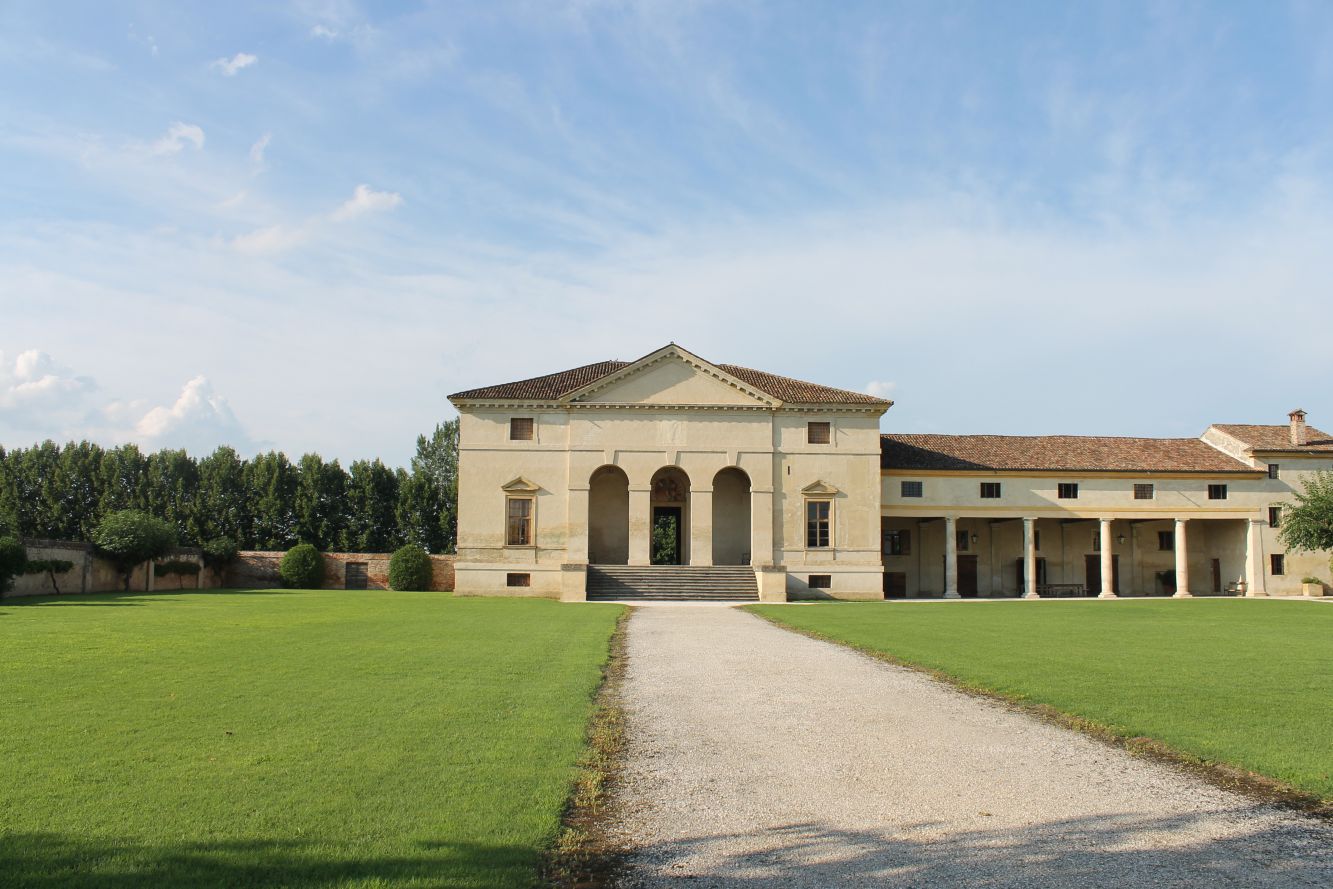 (1565-70 - Arch. Palladio)
(1565-70 - Arch. Palladio)
Address: AGUGLIARO - via Finale 8 -
e-mail: This email address is being protected from spambots. You need JavaScript enabled to view it.
web: www.landmarktrust.org.uk
ALBETTONE
VILLA ERIZZO SCHIAVINATO "CA' BRUSA'"
Address: ALBETTONE - Strada Lovolo 24/25 - tel. 339 8427996 - 0444 790596
ALTAVILLA VICENTINA
VILLA VALMARANA MOROSINI (1724 Arch. Muttoni)
Address: ALTAVILLA VIC.NA - via Marconi 103 - tel. 0444 333735 - fax 0444 333998
e-mail: This email address is being protected from spambots. You need JavaScript enabled to view it.
web: www.cuoa.it
ARCUGNANO
VILLA FRANCESCHINI CANERA DI SALASCO (1770 Arch. Scamozzi)
Indirizzo: ARCUGNANO - via Roma 4 - tel. 0444 270113
ARZIGNANO
VILLA MATTARELLO (1738)
Address: ARZIGNANO - Corso Mazzini 22 - tel. 0444 452723
VILLA BRUSAROSCO
Address: ARZIGNANO - Via IV novembre 39 - tel. 0444 476543
BARBARANO VICENTINO
VILLA SANGIANTOFETTI-RIGON
Address: Via Crispi 2 - tel. 0444 795319 - fax 0444 385812
e-mail: This email address is being protected from spambots. You need JavaScript enabled to view it.
web: www.villarigon.it
BASSANO DEL GRAPPA
VILLA REZZONICO- BORELLA
Address: BASSANO - via Ca' Rezzonico 64/72 -340 097 06 19
web: www.villarezzonicoborella.com
VILLA BIANCHI- MICHIEL
Address: loc. S.Eusebio, 15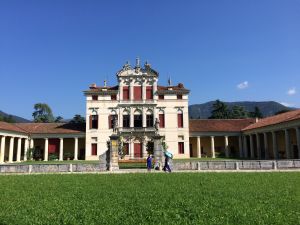
BOLZANO VICENTINO
VILLA VALMARANA ZEN
Address: Loc. Lisiera - via Ponte 1
BREGANZE
VILLA COLOMBARA PAGELLO-MONZA
Address: BREGANZE - via Fioravanzo
BRENDOLA
VILLA PIOVENE
Address: Piazza Marconi 1
tel. 0444 400727 - fax 0444 401099
e-mail: demografici@comune.brendola.it
web: www.comune.brendola.vi.it
BRESSANVIDO
VILLA MEZZALIRA (su edificio del 1400, aggiunte di fine 1700)
Address: BRESSANVIDO - via S. Benedetto 27 - tel. 0444 660974
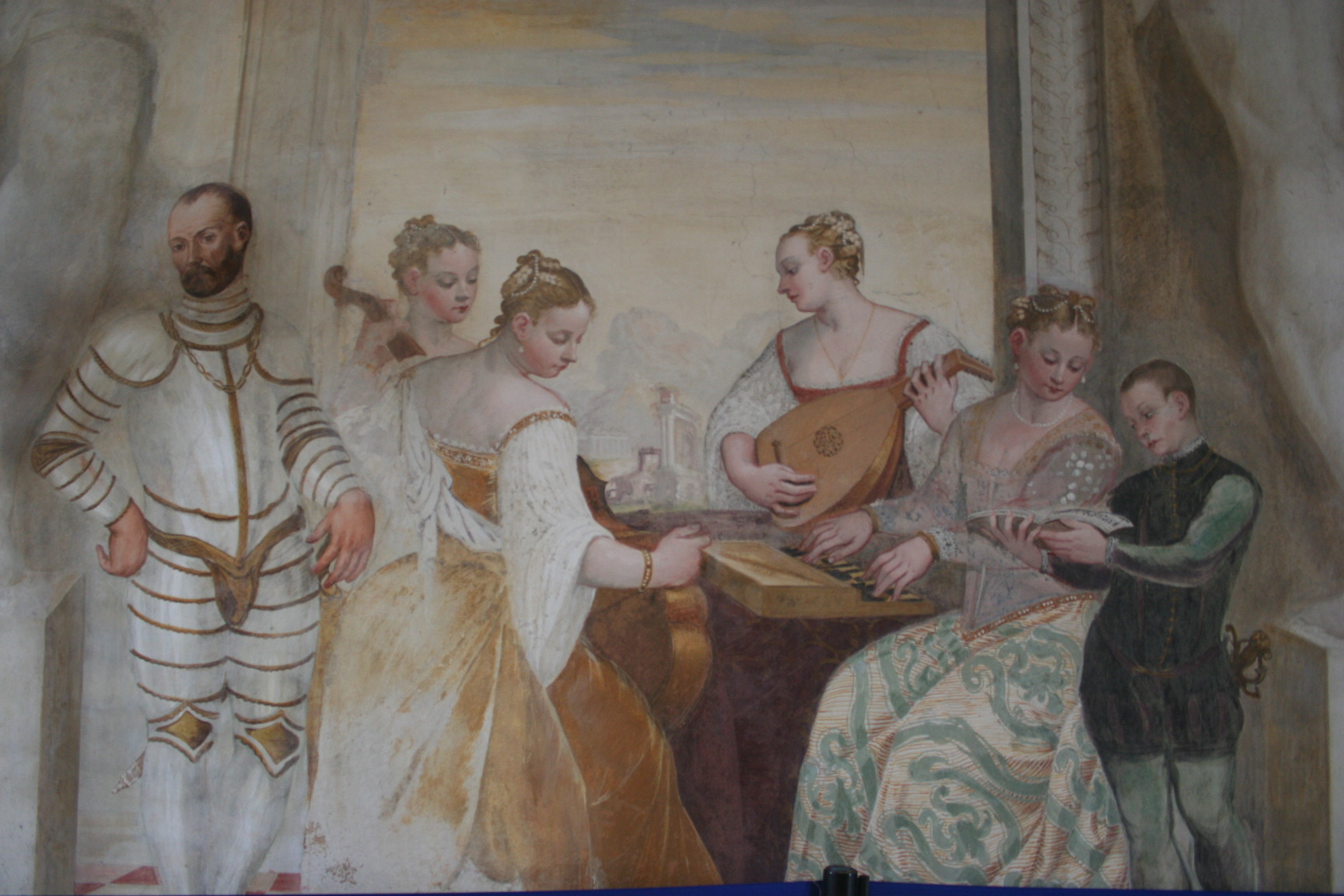 CALDOGNO
CALDOGNO
VILLA CALDOGNO (1570 Arch. Palladio)
Address: CALDOGNO - via Zanella 3 -tel. 345/9302084, This email address is being protected from spambots. You need JavaScript enabled to view it. - www.villacaldogno.it
CAMPIGLIA DEI BERICI
VILLA REPETA BRESSAN
Address: Piazza Vecchia, 1 - tel. 0444 866032
CARTIGLIANO
VILLA MOROSINI CAPPELLO (Attr. Arch. Zamberlan)
Address: CARTIGLIANO - Piazza Concordia 1 - tel. 0424 592696 - 590234 - fax 0424 828309
web: www.comune.cartigliano.vi.it
CASTELGOMBERTO
VILLA PIOVENE DA PORTO DA SCHIO
Address: CASTELGOMBERTO - via Villa 117 - tel. 335 5624190
web: www.villadaschio.com,
VILLA TRISSINO BARBARAN (1700)
Address: CASTELGOMBERTO - via Villa, 26 - tel. 0445 424411- fax 0445 941577 - 0445 440200
web: www.castelgomberto.vicenza.it
COSTABISSARA
VILLA SAN CARLO (1877 ristrutturata dal Calderari)
Address: COSTABISSARA Via San Carlo 1 - tel. 0444 971031 fax 0444 970933
e-mail: This email address is being protected from spambots. You need JavaScript enabled to view it.
CREAZZO
VILLA FADINELLI-SUPPIEJ (1790 Arch. V.Scamozzi)
Address: CREAZZO - Via Pozzetto 38 - tel. 0444 521014 / 0444 546824 - cell. 340 7980480
DUEVILLE
VILLA MONZA (1715 Arch. Muttoni)
Address: DUEVILLE - Piazza Monza 1 - tel. 0444 367211, fax 0444 367382
web: www.comune.dueville.vi.it
VILLA DA PORTO CASAROTTO
Address: DUEVILLE - Via Da Porto, 89 - tel. 0444 590709 - 348 6007291 - fax 0444 360821
e-mail: This email address is being protected from spambots. You need JavaScript enabled to view it.
web: www.villadaportocasarotto.com
VILLA DA PORTO PEDROTTI (Del Conte)
Address: Via Da Porto, 7 - Loc. Vivaro - tel. 0444 659344
GRUMOLO DELLE ABBADESSE
VILLA CHIERICATI DA PORTO RIGO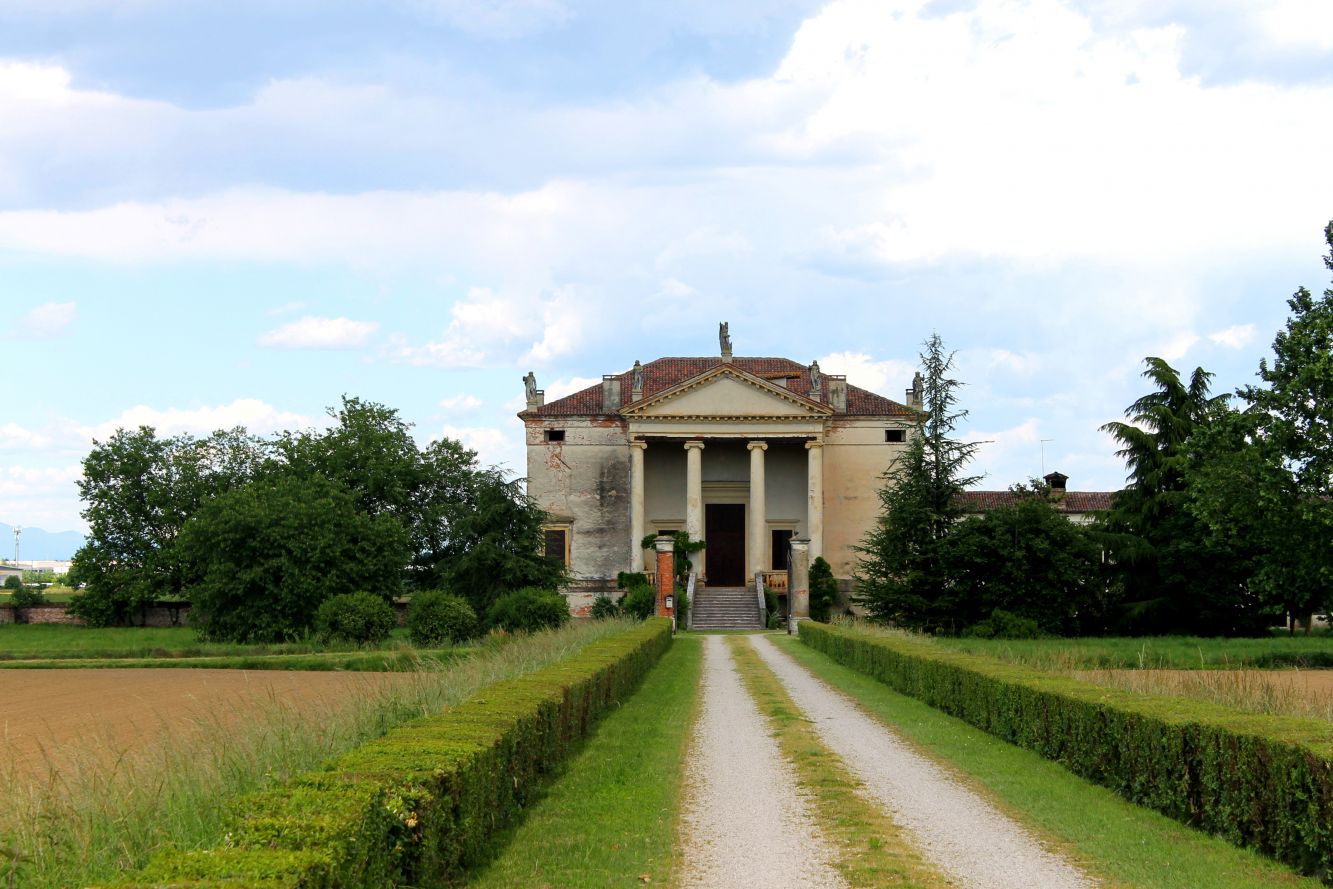
Address: GRUMOLO - via Nazionale 1 (loc. Vancimuglio)
VILLA GODI PIOVENE PORTO GODI
Address: SARMEGO - via Piovene 4 - tel. e fax 0445 361520 - 348 7817645
web: www.villagodipiovene.it"
VILLA CANAL
Address: GRUMOLO - Via Piave, 25 - cell. 338 8140998
web: www.villacanal.it
LONGARE
VILLA AEOLIA
Address: Piazza da Schio ,1 - Loc. Costozza
e-mail: This email address is being protected from spambots. You need JavaScript enabled to view it.
web: www.aeolia.com
PARCO DI VILLA DA SCHIO
Address: COSTOZZA - Piazza Giovanni Da Schio 4 - tel e fax 0444 555099 cell. 340 485456
web: www.costozza-villadaschio.it
VILLA TRENTO CARLI
Address: COSTOZZA - via B. Bixio 8 - tel. 0444 0444 555038
LONIGO
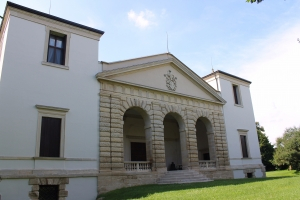 VILLA PISANI BONETTI
VILLA PISANI BONETTI
Address: BAGNOLO di LONIGO - via Risaie 1 - tel. 0444 831104 - Fax 0444 835517
web: www.villapisani.net
VILLA PISANI FERRI "ROCCA PISANA"
Address: LONIGO - via Rocca 1 - tel. 0444 831625 - www.laroccapisana.com
VILLA S. FERMO DEI RELIGIOSI PAVONIANI (1867)
Address: LONIGO - via S. Fermo, 17
tel. 0444 830067 - fax 0444 432042 - www.villasanfermo.com
LUGO VICENTINO
VILLA GODI MALINVERNI
Address: LONEDO - via Palladio 44 - tel. 0445860358 - 339 3429942
web: www.villagodi.com
VILLA PIOVENE PORTO GODI
Address: LONEDO - via Palladio 51 - tel. 0445 860613 - 347 7494424
MASON
VILLA ANGARAN CATTANEO "DELLE STELLE"
Address: Via Braglio, 36 - tel. 0424 411456 - 349 5259226
e-mail: This email address is being protected from spambots. You need JavaScript enabled to view it.
VILLA SAN BIAGIO AL MONASTERO
MONTECCHIO MAGGIORE
 VILLA CORDELLINA LOMBARDI
VILLA CORDELLINA LOMBARDI
Address: MONTECCHIO M.RE - via Lovara, 36 - tel. 0444 908141 - fax 0444 326556
web: www.provincia.vicenza.it
MONTECCHIO PRECALCINO
VILLA DA SCHIO CITA
Address: MONTECCHIO P.INO - via S. Rocco, 19 - tel. 338 6050348 - Pro Loco
web: www.comune.montecchioprecalcino.vi.it
MONTEGALDA
CASTELLO GRIMANI SORLINI
Address: MONTEGALDA - via Castello 21 - tel. 030 601031 - fax 030 601491
VILLA FOGAZZARO COLBACHINI - MUSEO VENETO DELLE CAMPANE
Address: MONTEGALDA - via A. Fogazzaro, 3 - tel. 0444 737526 - fax 0444 735623
www.muvec.it
MONTEVIALE
VILLA LOSCHI ZILERI MOTTERLE (1734 Arch. Muttoni o Massari)
Address: BIRON - viale Zileri 4/6 - tel. 0444 964190 - fax 0444 964210
MONTICELLO CONTE OTTO
VILLA VALMARANA BRESSAN (Arch. Andrea Palladio)
Address: VIGARDOLO - via Vigardoletto, 31 - tel 337 488693
www.villavalmaranabressan.it
MONTORSO VICENTINO
VILLA DA PORTO BARBARAN
Address: Via L. Da Porto, 9 - tel 0444 685402 - 0444 685969 - fax 0444 484057
MOSSANOVILLA PIGAFETTA CAMERINI DI MONTRUGLIO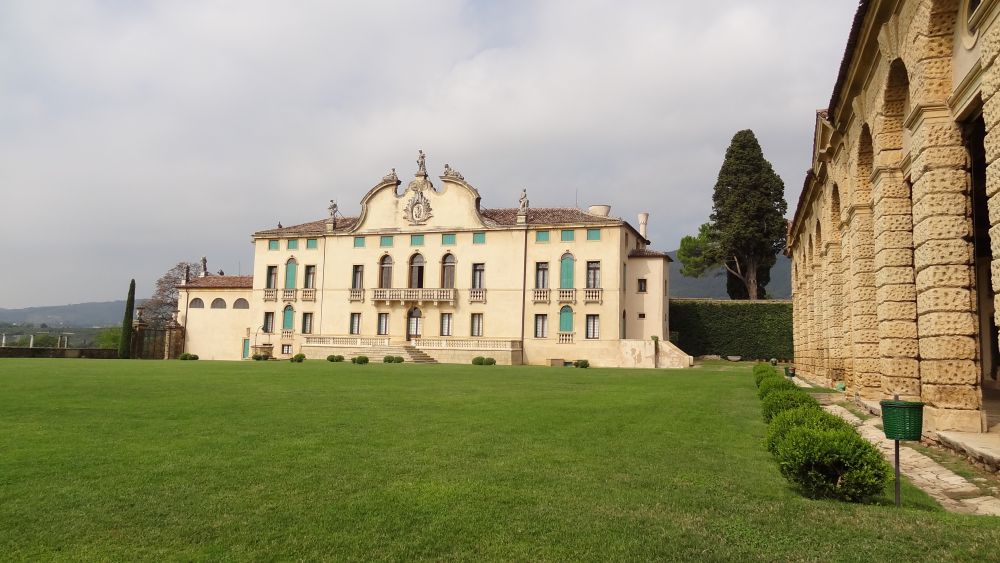
Address: MOSSANO - via Montruglio 9 - tel. 0444 886838 fax. 0444 776138
web:
www.villadimontruglio.it
NOVENTA VICENTINA
VILLA BARBARIGO
Address: NOVENTA Piazza IV Novembre 1
tel. 0444 788511 - 0444 788520 - fax 0444 760156
web: www.comune.noventa-vicentina.vi.it
VILLA MANIN CANTARELLA
VILLA POJANA PROSDOCIMI (1700) Address: NOVENTA via De Gasperi 3 - tel.fax 0444 887868
e-mail:
This email address is being protected from spambots. You need JavaScript enabled to view it.
ORGIANOVILLA FRACANZAN PIOVENE (1710 Arch. Muttoni)
Address: ORGIANO via S. Francesco 2 - tel. 0444 874589, tel. 02 72003658
web:
www.villafracanzanpiovene.com POJANA MAGGIOREVILLA POJANA(1555 Arch. Palladio)
SAN GERMANO DEI BERICI
VILLA DOLFIN - MISTRORIGO
Address: Via Campolongo 5 - tel 0444 868034 - Ref. Luciano Mistrorigo
SANDRIGO
VILLA CHIERICATI MILAN (1623)
Address: ANCIGNANO via Soella, 7 - tel. 0444 510627 - cell. 348 8107185 / 3402429137
e-mail This email address is being protected from spambots. You need JavaScript enabled to view it.
VILLA SESSO SCHIAVO
Address: via S. Lorenzo 5 - tel. 0444 659344,
www.villasessoschiavo.it
VILLA E ORATORIO SESSO BORDIGNON
Address: Via S. Gaetano 22 - tel. 0444 1460680
e-mail: This email address is being protected from spambots. You need JavaScript enabled to view it.
SARCEDO
VILLA CAPRA BASSANI(seconda metà del 1700 Capra) -
SAREGO
VILLA DA PORTO "LA FAVORITA"
Address: Loc. Monticello di Fara Via Strada della Favorita
cell. 335 7685710
VILLA SALE S. DAMIANO CURTI
Address: SOVIZZO - via Roma 64 - cell. 347 3657180
web: www.villacurti.it
THIENE
VILLA CA' BEREGANE
Address: via Cà Beregane 1- tel. 348 3019581 fax 0445 380944
CASTELLO PORTO COLLEONI THIENE Address: THIENE Corso Garibaldi, 2 - tel - fax 0445 366015
web:
www.castellodithiene.com
TRISSINOVILLA E PARCO TRISSINO MARZOTTO (Arch. Muttoni, Dal Pozzo, Calderari)
VELO D' ASTICO
VILLA MONTANINA
Address: via montanina 1 - tel. 0445 712140 - 0445 740320 / 740898 - 0445 740355 (Montanina) - fax 0445 741818 - 0445 740355
web: www.comune.velodastico.vi.it
VILLA VELO - LAMPERTICO - VALMARANA CISCATO
Address: Via C. Venini Loc. Seghe di Velo D'Astico - tel. 0445 712140 - 0445 740320 / 740898 - 0445 740355 - fax 0445 741818 - 0445 740355
web: www.comune.velodastico.vi.it
VALDAGNO
VILLA VALLE MARZOTTO (fine 1600 Attr. Arch. Frigimelica Roberti) Address: viale Regina Margherita 1 - tel. 0445 401887 fax 0445 409724
web:
www.comune.valdagno.vi.it
VILLAVERLA
VILLA GHELLINI
Address: VILLAVERLA via S. Antonio 6 - tel. 0445 856073 - fax 0445 357112
VILLA VERLATO
Address: VILLAVERLA Piazza del Popolo 1 - tel. 348 3519260 - fax. 0444 570204
ZUGLIANO
VILLA GIUSTI DEL GIARDINO-SUMAN (1600)
Address: ZUGLIANO via Villa 16 - tel. 0445 330115 - fax 0445 330029
web: www.villagiusti.it
How can I reach the closest villas on foot from the city centre of Vicenza? Can I get to the Sanctuary of Monte Berico on foot? Is Villa Valmarana ai Nani far from Villa La Rotonda? What is the best itinerary to see all the Palladian buildings located in the city centre?
You canfind the answers to each question by following these itineraries, either on foot or by bike!
*From the city centre to Monte Berico
Download the gpx Download and print the pdf
*From Monte Berico to the Villas
Download the gpx Download and print the pdf
*From the city centre to the Villas
Download the gpx Download and print the pdf
*Palladian itinerary in Vicenza
Discover the Palladian buildings of the city centre on foot

Museums in Vicenza can be visited with a combined card - the Vicenza Card-, with a 4Museums Card or with single museum tickets.
The Vicenza Card is valid for 8 days from the day of issue and it gives access to 11 sights:
Teatro Olimpico, Civic Art Gallery of Palazzo Chiericati, Palazzo Thiene, Natural History and Archaeological Museum, Risorgimento and Resistance Museum, Santa Corona Church, Diocesan Museum, Palladio Museum, Gallerie d'Italia - Palazzo Leoni Montanari, Palladian Basilica (exhibitions excluded), Jewellery Museum.
The 4 Museums Card is valid for 8 days from the day of issue and grants the access to 4 sites to be chosen from the ones included in the museum network.
You can buy the cards at:
Teatro Olimpico (Tourist office in Piazza Matteotti 12), Gallerie d’Italia - Palazzo Leoni Montanari, Palladio Museum, Diocesan Museum, Jewellery Museum, Basilica Palladiana.
Info at http://www.teatrolimpicovicenza.it/en/
DOWNLOAD THE PDF WITH PRICES AND OPENING TIMES
DOWNLOAD THE CITY MAP
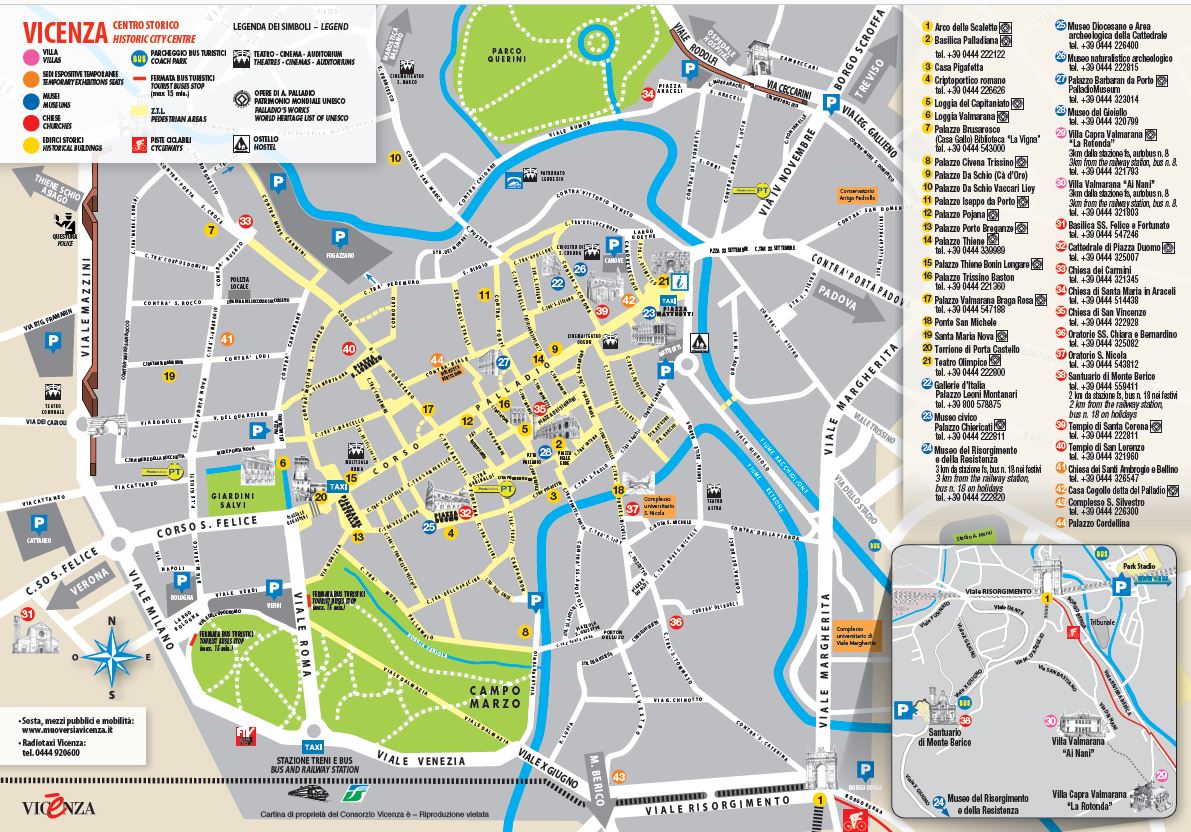
Thanks to the genius of Andrea Palladio, Vicenza and the villas have achieved world recognition, a status consecrated in modern times with the inclusion in the UNESCO World Heritage List.
Moreover, Vicenza has a lot to offer from several points of view, not to mention the precious Christian, artistic and architectural heritage and numerous museums. Throughout the centuries, important characters have greatly influenced its story and growth, from Vincenzo Scamozzi to the Tiepolos, from Giangiorgio Trissino to Antonio Pigafetta, Goffredo Parise, Guido Piovene and many other writers and artists.
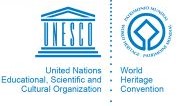 In the mid-nineties, the UNESCO, the UN Agency for Science and Culture, enlisted Vicenza and the Palladian Villas inside its prestigious World Heritage List with the following statement:
In the mid-nineties, the UNESCO, the UN Agency for Science and Culture, enlisted Vicenza and the Palladian Villas inside its prestigious World Heritage List with the following statement:
- Vicenza is an exceptional artistic creation considering the numerous architectural contributions made by Andrea Palladio, all of which are integrated into a historical context that gives the city its overall character
- The city’s architecture has had a strong influence over the architecture and urban planning in the majority of European countries and the world
and therefore, in accordance with the following selection criteria laid down in the Convention:
i) to represent a masterpiece of human creative genius;
ii) to exhibit an important interchange of human values, over a span of time or within a cultural area of the world, on developments in architecture or technology, monumental arts, town-planning or landscape design;
Read the offical article on the Unesco website
… but what is the best itinerary to visit the main Palladian masterpieces of the city centre? An enjoyable, simple walk suitable for everyone, starting from the Tourist information office in Piazza Matteotti, right next to the entrance of the Olympic Theatre.
THE PALLADIAN ITINERARY IN THE HISTORIC CENTRE
Download the PDF here or the GPX on All Trails here below
The itinerary is also available on OutdoorActive
... THE VILLA DESIGNED BY ANDREA PALLADIO IN THE VICENTINE AREA
-
VILLA CAPRA VALMARANA detta "LA ROTONDA"
-
VILLA GAZZOTTI GRIMANI CURTI
-
VILLA THIENE
- VILLA VALMARANA SCAGNOLARI ZEN
-
VILLA VALMARANA BRESSAN
-
VILLA CALDOGNO
-
VILLA TRISSINO TRETTENERO
-
VILLA CHIERICATI DA PORTO RIGO
-
VILLA SARACENO THE LANDMARK TRUST
-
VILLA POJANA
-
VILLA PISANI BONETTI
-
VILLA TRISSINO
-
VILLA FORNI CERATO
-
VILLA PORTO THIENE
-
VILLA GODI MALINVERNI
-
VILLA PIOVENE PORTO GODI
-
VILLA ANGARANO BIANCHI MICHIEL
THE "VILLE TIEPOLESCHE" (tiepolesque villas)
 The expression "Ville Tiepolesche" gathers those villas in which Gianbattista Tiepolo worked in Vicenza's province, leaving various frescos and paintings. In 1734 he frescoed the interiors of Villa Loschi at Biron in Monteviale; in 1743 worked at villa Cordellina. In 1757 he transformed a modest architectural construction into that famous art masterpiece which is now best known as villa Valmarana ai Nani. His artistic contribution in these villas is so remarkable that they are nowadays more famous for his frescos than for their architectural value. Tiepolo's contributions to the Palladian villas represents the changing of his age: he lived and worked between the Renaissance and the Enlightenment. According to Palladio the villa was the centre of the agricultural life; on the other hand Tiepolo's villa becomes a prestigious residence, place for freedom and liberty unlike citylife.
The expression "Ville Tiepolesche" gathers those villas in which Gianbattista Tiepolo worked in Vicenza's province, leaving various frescos and paintings. In 1734 he frescoed the interiors of Villa Loschi at Biron in Monteviale; in 1743 worked at villa Cordellina. In 1757 he transformed a modest architectural construction into that famous art masterpiece which is now best known as villa Valmarana ai Nani. His artistic contribution in these villas is so remarkable that they are nowadays more famous for his frescos than for their architectural value. Tiepolo's contributions to the Palladian villas represents the changing of his age: he lived and worked between the Renaissance and the Enlightenment. According to Palladio the villa was the centre of the agricultural life; on the other hand Tiepolo's villa becomes a prestigious residence, place for freedom and liberty unlike citylife.
VISITS TO THE VILLE TIEPOLESCHE
Villa Valmarana ai nani
Vicenza - 2 km from the historic center in direction of the ss 247 Riviera Berica
Via dei Nani - tel. 0444 321803 https://www.villavalmarana.com/en/
Villa Cordellina Lombardi
Montecchio Maggiore - 11 km. from Vicenza s.s. 11 towards Verona
Via Lovara, 36 - tel. 0444 696085 - 0444 908214 https://www.provincia.vicenza.it/villa-cordellina-lombardi
Villa Loschi Zileri Motterle
Monteviale - localita' Biron - 4 Km from the historic center
Via Zileri, 1 - tel. 0444 964190 https://www.villazileri.com/en/index.html
TIEPOLO: THE SPREAD MUSEUM
CHIESA DI S.STEFANO (St. Steven's church) - Vicenza historic center
In this church the tabernacle of the high altar is adorned with three painting s by Giandomenico Tiepolo. They probably date back to the years 1758/60. The pictures in golden monochrome represent "S. Pierto", "S. Giovanni battista" and "La Resurrezione". The first two works can be ascribed to Giandomenico, whereas the third and part iculary the picture showing the soldiers hit by the divine light are his father's creation.
CHIESA DEI SS. VITO, MODESTO e CRESCENZIA (Church if ss. Vito, Modesto and Crescenzia) - Noventa Vicentina
The eighteenth century church of Noventa Vicentina is adorned with the altar-piece dedicated to "S. Rocco e S. Sebastiano" placed on a side altar. This oil-painting dates back to the years 1758/60. The realism of the paralytic old woman is opposed to the figures of the two saints: the wounded Sebastian bound to the tree is looking at the invalid, whereas Rocco is standing and looking upwards, towards the Heaven.
CHIESA DI SANTA MARIA MADDALENA (St. Mary Magdalene's church) - Rampazzo (Camisano Vicentino)
The paintings representing "the Apotheosis of St. Gaetano Thiene" is contemporaneous of the frescoes of Villa Valmarana (1757) and it was ordered by the Thiene family. The little church appearing in this painting reminds the working to built the parish church ordered by the same saint. St. Gaetano is reaching God lifted from the clouds. As remarked by Remo Schiavo, the artist prefers the "soft, light, rosy hues, as in the frescoes of Villa Valmarana punctually reminded by the silk clothes and the soft Puttos".
PALAZZO CHIERICATI - palace - Vicenza historic center
The works by the Tiepolo family kept in Civic Art Gallery are five: "L'immacolata concezione" and "Il Tempo che sopre la verita' " by Giambattista and "La Decollazione del Battista", “Enea e Anchise” and “Testa di Mercante” by Giandomenico.
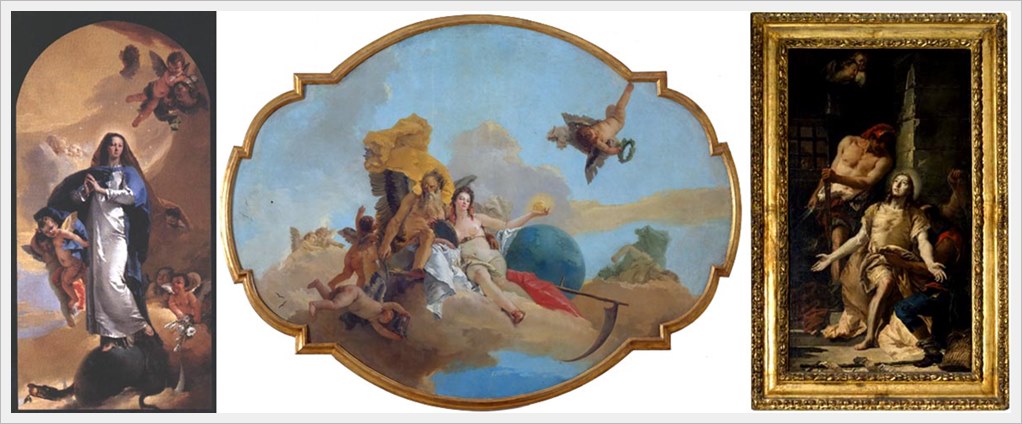
"L’immacolata concezione" comes from the splendid church of Ara Coeli designed at the end of the Seventeenth century. This piece had adorned the Crucifix Altar until purchased by the Earl Barbieri in 1830. This painting, dating back to approximately 1735, shows all its magnificence in the silver dress and in the blue mantle of the Virgin Mary. The colour vary from a very light azure to dark blue. The red cloak of the angels at the right of the Virgin shades into yellow.
"La Verità svelata dal Tempo" was found in Palazzo Cordellina, located in Contrà Riale, right in the historic centre, even though it is believed it was once housed in Cordellina's villa in Montecchio Maggiore, as it is contemporary to the frescoes that decorate the villa (1743/44). Remo Schiavo states that this painting was placed on the ceiling of the pronaos, but this hypothesis is refuted by Fasolo and Puppi for the lack of a suitable place to hang the painting in the villa. The actual place of origin still remains unconfirmed. The picture is focused on the figure of the naked woman; as it is mentioned by Andreina Ballarin, she "almost cancels the rather gruesome zones of this Illuminist "moral", that is the "ancient" fleshes of the old man representing Time, the scythe, the hourglass, the hero's wreck".
"La Decollazione di San Giovanni Battista", attributed to Giambattista Tiepolo until 1910, was actually painted by Giandomenico. The emotional centre of the picture is the Saint's face enlightened by a divine light. The figure of the Baptist is opposed to that of the executioner and the darkness of the place increases the emotion.
“Aeneas and Anchises” was also mistakenly attributed to Giambattista; Giandomenico regained the authorship of the work in 1953, thanks to the studies of Giuseppe Fiocco. This painting recalls the left section of a sketch preserved in Helsinki and entitled “The Greek assault Troy on fire”: the character of Aeneas, tightening his grip on the Penates, carries his father Anchises on the shoulders while holding his son Ascanium by the hand, recognisable at the bottom of the composition.
“Testa di Mercante” belongs to the portrait category and, in particular, to a series of canvas with similar subjects and dimensions painted by the artists in Tiepolo’s workshop and usually attributed (even if not with complete certainty) to Giambattista. On the stylistic level, the character’s cunning and very plebeian appearance, as well as the gleam in the shrewd and pungent look, point towards the artistic language adopted by Giandomenico, quite different from the more refined stroke that characterized his father’s works.
Source: Scientific catalogue – Civic Art Gallery of Palazzo Chiericati
MUSEO CIVICO (civic museum) - Bassano del Grappa historic center
The Municipal Museum of Bassano keeps one of the greatest collections of drawings of Venetian artists; especially the "Corpus di disegni Riva" includes some works of the greatest authors, particularly of Giambattista and Giandomenico Tiepolo. Moreover, in the picture-gallery there is a painting by Gianbattista Tiepolo dating back to approximately 1731/32 a nd representing the event of "Circoncisione". There is also a splendid painting representing the "Madonna con Bambino" by Giandomenico Tiepolo. The child is moving and caressing his mother's face. The Virgin has a sweet, tender look symboliz ing the motherly love.
|
|
|
See here opening times and rates of
villas, monuments, churches of Vicenza and its surroundings!
|
THE ROMAN CRYPTOPORTICUS - VICENZA
In 1954, in the southern side of Piazza Duomo, has been discovered a Roman construction, quite unusual in the fabric of a northern Roman city: a cryptoporticus, a sort of underground gallery which floor is nowadays m 6,31 deep compared to the modern trampling level, constituted by the threshold of the square.
The condition of the structure allows us to get a good readability, especially in the most eastern part of the monument to which belong three wings and two quadrangular rooms. The walls of this section are plastered; a stucco moulding, underneath which runs a deep red band, underlines the springer.
The stairwell still preserves some traces of the high black base and the Pompeian red decoration above, with squares limited by thin, green and light blue bands.
The other sections of the complex, constituted by a trapezoidal room and an oblique gallery, are harder to read.
The three different floor levels testify that the building went through many different use phases: the oldest one can be traced back to the end of the I century b.C.
Information for visits: Centro Turistico Giovanile, ph. +39 0444 226626
THE RUPESTRIAN INSCRIPTIONS IN VAL D'ASSA- Roana (Plateau of Asiago)
Tunkebalt reachable from Canove or Roana
Val d'Assa is a deep valley, which divides the Altopiano into two parts, separating, on the West Side, Rotzo and some little villages in Roana from the other districts.
The first discoveries in Tunkebalt (Bosco Nero), date back to 1979. 10,000 inscriptions were found in a 40 meters long and 7 meters tall location, where you can still see animal and human figures, cross-shaped and geometrical forms, sexual symbols, representations of the sun and building projects.
Open for visits.
VALLE DEL BISELE near Val d'Assa
It is an archeological area characterized by the so-called "Laita Kubele": a large natural cave with paleontologic material.
VILLAGE OF BOSTEL
 It is situated in Castelletto di Rotzo and is considered the first human village of the Altopiano with hundreds little houses, containing up till one thousand people. Open for visits.
It is situated in Castelletto di Rotzo and is considered the first human village of the Altopiano with hundreds little houses, containing up till one thousand people. Open for visits.
THE FUNERAL MEGALITHIC COMPLEX IN SOVIZZO - San Daniele. (Copper age)
In 1990-1991, during the workings for civil constructions, prehistoric remains were discovered: an ancient Neolithic ground (end of IV millennium bc.) and a grave (III millennium bc.) were found in the area between Viale degli Alpini and Via Alfieri. In the south part of Viale degli Alpini, was the funeral megalithic complex of the same age. It is now an archeological area visible from the outside. Sovizzo is also famous for numerous Longobard graves, discovered at the beginning of 1900 in the propriety owned by Conte Giovanni Curti. The Villa is now visitable by appointment. Conte Giovanni Curti's precious belongings are instead exposed in the Museo Civico of Vicenza. Sovizzo is a residential area located few kilometers from Vicenza, not far from Colli Berici.
ALTAR KNOTTO
To sink into the legend you can reach the Altar Knotto, near Rotzo: a seat of revengeful gods as the ancient Cimbric people believed.
CIMA MARANA AND CAMPETTO in Recoaro Mille
Cima Marana and Campetto, with their recent finds (coins, glasses, urn's pieces) related to Longobard Era are important mountain archeology locations. Today you can visit the place following a path surrounded by the Small Dolomites landscape. Most of the objects found are displayed in the Civic Museam “Dal Lago” in Valdagno.
INDUSTRIAL ARCHEOLOGY in Valdagno
"Social Town" and “Museum of Textile Machineries”. Project endorsed in XX by the wool enterpreneur Gaetano Marzotto for the workers of his factory, consists of buildings erected for social, cultural, sporting and living purposes. Besides, the Museum of Textile Machineries representing the progressive technology development of a producing sector which strongly marked the surrounding environment.
INDUSTRIAL ARCHEOLOGY: SCHIO, THE ORIGINS OF ITALIAN MODERN INDUSTRY
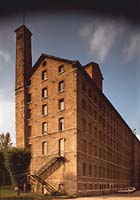 The valley of Leogra river is an ample furrow that, from the lowland opening where the city of Schio, Italian capital of industrial heritage, is situated and proceeds in North-Westerly direction toward Pian delle Fugazze, to the base of Mount Pasubio. Schio inserts itself among the buttresses of Mount Summano and Novegno to the East and the Piccole Dolomiti, famous scenario of Word War I. The traditional agricultural and sheep-farming economy has been accompanied, since the Middle Ages, by craftmanship, evidenced by the dense net of mills, sawmills, drop-hammers and wool machinery, which sprang up along the course of the Leogra and of the Roggia Maestra (the main canal), the latter being a by-pass from the river itself constructed toward the middle of the 13th C., along the boundary of Schio with Pievebelvicino. The Roggia Maestra has determined the economic life of the population and the structure of Schio's city-centre, where there are 12 waterfalls regulated by a system of locks. The part of the roggia between Torrebelvicino and Pievebelvicino is, on the other hand, dated back to last century. The availability of hydraulic energy was fundamental for the industrial development, which occurred in the 19th century: it was, in fact a waterfall which moved the machinery through transmission chains. As in other geographical areas of Northern Italy, in the Val Leogra as well, one can observe the progressive transfer of the productive installations from the hills toward the lowland, the river always being necessary to the adoption of steam and then electricity as sources of energy. The pole of attraction not only of the valley, but of the whole Alto Vicentino (the northern territories of the Vicenza province), is Schio, which became around 1870 the capital city of the wool industry - the Manchester of Italy, or the "civitas" in the ideological conception of Alessandro Rossi based on the factory system. To testify to the ancient protoindustrial activity and the most recent industrial tradition of the val Leogra one can study various remains of different typologies from mills to sawmills, from spinning-mills to wool mills, from drop-hammers to mechanics industries, from the houses built for employees to the working class districts, etc. But dominating over everithing else, together the towering brick factory chimineys, is the Fabbrica Alta (high factory), real "cathedral to labour", eloquent sign of the European dimension of the Schio industrial phenomenon. To explore these testimonies means to reconstruct the net of relationships and of objects which sprang up around the workshops, the behaviours, the ways of being, the ideas that have gave to one of the most interesting chapters of the industrial civilisation of the Veneto region.
The valley of Leogra river is an ample furrow that, from the lowland opening where the city of Schio, Italian capital of industrial heritage, is situated and proceeds in North-Westerly direction toward Pian delle Fugazze, to the base of Mount Pasubio. Schio inserts itself among the buttresses of Mount Summano and Novegno to the East and the Piccole Dolomiti, famous scenario of Word War I. The traditional agricultural and sheep-farming economy has been accompanied, since the Middle Ages, by craftmanship, evidenced by the dense net of mills, sawmills, drop-hammers and wool machinery, which sprang up along the course of the Leogra and of the Roggia Maestra (the main canal), the latter being a by-pass from the river itself constructed toward the middle of the 13th C., along the boundary of Schio with Pievebelvicino. The Roggia Maestra has determined the economic life of the population and the structure of Schio's city-centre, where there are 12 waterfalls regulated by a system of locks. The part of the roggia between Torrebelvicino and Pievebelvicino is, on the other hand, dated back to last century. The availability of hydraulic energy was fundamental for the industrial development, which occurred in the 19th century: it was, in fact a waterfall which moved the machinery through transmission chains. As in other geographical areas of Northern Italy, in the Val Leogra as well, one can observe the progressive transfer of the productive installations from the hills toward the lowland, the river always being necessary to the adoption of steam and then electricity as sources of energy. The pole of attraction not only of the valley, but of the whole Alto Vicentino (the northern territories of the Vicenza province), is Schio, which became around 1870 the capital city of the wool industry - the Manchester of Italy, or the "civitas" in the ideological conception of Alessandro Rossi based on the factory system. To testify to the ancient protoindustrial activity and the most recent industrial tradition of the val Leogra one can study various remains of different typologies from mills to sawmills, from spinning-mills to wool mills, from drop-hammers to mechanics industries, from the houses built for employees to the working class districts, etc. But dominating over everithing else, together the towering brick factory chimineys, is the Fabbrica Alta (high factory), real "cathedral to labour", eloquent sign of the European dimension of the Schio industrial phenomenon. To explore these testimonies means to reconstruct the net of relationships and of objects which sprang up around the workshops, the behaviours, the ways of being, the ideas that have gave to one of the most interesting chapters of the industrial civilisation of the Veneto region.
THE OUTDOOR MUSEUM OF INDUSTRIAL HERITAGE
The Bureau of Culture of the city of Schio and the Teachers' Centre of Democratic Initiative, several years ago started a common action of conservation and revaluation of the evidences of the machinery civilisation, by developing and creating a favourable climate of opinion, in paticular that of the young people, by activating cultural tourism and organising, among the other activities, an Outdoor museum of Industrial heritage. The objects exhibited are the industrial monuments diffused in the territory of the Val Leogra and the Alto Vicentino in general, while the population is the soul and depositary of the historic memory.
CRUSTACEA AND FOSSILS IN VICENZA AREA
The territory around Vicenza, that spaces from the eastern Lessini to the flat land, from the Small Dolomites to the Grappa Massif, in the geological past was covered by the sea. The environments that came after each other during this long period of about 300 million years, were characterized by lands above sea-level, coral atolls and volcanic phenomena more or less violent. The presence of fossil crabs in our territory has interested the scholars since the past centuries; however, lots of new species have been discovered in the last twenty years during construction and street works, that surprisingly brought to light some full-blown crustacea layers.
The finds discovered in Vicenza area are nowadays kept in the naturalistic-archaeological museum of Vicenza, in the civic museum of Bassano del Grappa, in the fossils museum of Villa Godi Malinverni in Lonedo di Lugo, in the Priaboniano museum of Monte di Malo, in the paleontologic museum "Domenico Dal Lago" of Valdagno, in the museum "P. Aurelio Menin" of Chiampo, in the paleontologic museum ruled by the friars of Monte Berico in Vicenza and, above all, in the civic museum "G. Zannato" of Montecchio Maggiore, where we can admire the most complete and rich collection of fossils of all Vicenza area.
Extract from
"Quinto quaderno di Natura Vicentina: protagonisti i granchi fossili"
CULTURAL PARKS
 …. In fact, Vicenza’s doesn’t represent just an economical miracle, but also a cultural one. A miracle of writing and sculture, which can just be sketched by these pages: they suggest itineraries, sometimes with the effort of intellectuals and renowned people, who were fascinated by this land, and have kept some surprising aspects of it. With their effort we hope to amaze even the nowadays visitor, so that, after coming back home from his Grand Tour in Vicenza’s lands, he would feel pushed to pick up his old edition of Meneghello’s, Piovene’s, Parise’s or Fogazzaro’s operas, ended up somewhere on his bookshelves.
…. In fact, Vicenza’s doesn’t represent just an economical miracle, but also a cultural one. A miracle of writing and sculture, which can just be sketched by these pages: they suggest itineraries, sometimes with the effort of intellectuals and renowned people, who were fascinated by this land, and have kept some surprising aspects of it. With their effort we hope to amaze even the nowadays visitor, so that, after coming back home from his Grand Tour in Vicenza’s lands, he would feel pushed to pick up his old edition of Meneghello’s, Piovene’s, Parise’s or Fogazzaro’s operas, ended up somewhere on his bookshelves.
(translated version of a piece by Antonio Franzina, taken from “I parchi culturali del vicentino” edited by Touring Club Italiano)
In the following lines we list the authors, both from Vicenza and elsewere, throughout which the author identified “The cultural parks of Vicenza’s lands”. Before than real spaces with physical enclosures, they are also mobile and mental containers springing out of these artist’s works, from their “telling” Vicenza’s lands. The result was a nice guide, proper in giving hints, offering suggestions, stimulating the visitor , as it was said before, to read, or re-read.
If it's true , as the Touring Club itself suggests, that the tourist of the XXI century looms mature, conscious, informed, open minded , curious and, above all, responsible, then history, art and culture are going to be the attractions of the third millennium tourism; thus we consider important the operation, here shown, of exposition of Vicenza’s and Vicenza’s lands cultural patrimony, which is not only Palladio.
We are also sure that the Cultural Parks have a future and will become Cultural Businesses due to the residents’ interest in their history and the opportunity to further their knowledge. All of this can be transformed into events and shows combined with the area’s famous hospitability and traditional cuisine and, naturally, economic elements can be applied to culture to establish the foundations on which to build an innovative cultural tourism business.
People from VICENZA mentioned in the article:
Luigi da Porto - writer
Antonio Pigafetta - circumnavigator
Silvio Ceccato - writer
Pace Pasini - man of culture
Giuseppe Faggin - philosopher and writer
Guido Piovene - writer and journalist
Goffredo Parise - writer
Maddalena Campiglia - poet
Elisabetta Caminer Turra - editor
Pulice da Custoza - man of culture
Maestro Tuxio - poet
Aureliano Acanti - poet
Ilvo Diamanti - researcher and essayist
Sergio Romano - writer and ambassador
Renzo Ghiotto - journalist
Gigi Ghirotti - journalist
Gian Antonio Stella - journalist and writer
Antonio Fogazzaro - writer
Fernando Bandini - poet
Luigi Meneghello - writer
Arnaldo Fusinato - poet
Giacomo Zanella - poet
Giulio Bedeschi - writer
Mario Rigoni Stern - writer
Neri Pozza - editor
Virgilio Scapin - writer
Silvia Negro - writer
Magagnò, pseudonym of Maganza - painter and poet
Ambrogio Fusinato - poet
A particular kind of park: ECO-MYTHOLOGIC PARK FAIRIES WOOD
MUSEUMS IN VICENZA
CIVIC MUSEUM - PINACOTECA DI PALAZZO CHIERICATI
Seat: Palazzo Chiericati - Piazza Matteotti 37/39
tel. 0444 222811 / 0444 321348 / 0444 325071 - fax 0444 546619
 This email address is being protected from spambots. You need JavaScript enabled to view it.
This email address is being protected from spambots. You need JavaScript enabled to view it.
website: www.comune.vicenza.it - www.museicivicivicenza.it
 wheelchair access: total - equipped toilets: yes
wheelchair access: total - equipped toilets: yes
bus parking area: not available - car parking area: not available
NATURALISTIC-ARCHAEOLOGICAL MUSEUM OF S.CORONA
Seat: Chiostri di S. Corona - Contrà S. Corona 4
tel. 0444 222815 - fax 0444 325627
 This email address is being protected from spambots. You need JavaScript enabled to view it.
This email address is being protected from spambots. You need JavaScript enabled to view it.
website: www.comune.vicenza.it - www.museicivicivicenza.it
 wheelchair access: total - equipped toilets: yes
wheelchair access: total - equipped toilets: yes
bus parking area: not available - car parking area: not available
RISORGIMENTO AND RESISTANCE MUSEUM
Seat: Villa Guiccioli - Viale X Giugno 115
tel. 0444 322998- fax 0444 326023
 This email address is being protected from spambots. You need JavaScript enabled to view it.
This email address is being protected from spambots. You need JavaScript enabled to view it.
website: www.comune.vicenza.it - www.museicivicivicenza.it
 wheelchair access: partial
wheelchair access: partial
bus parking area: not available - car parking area: not available
GALLERIES OF PALAZZO LEONI MONTANARI
Seat: Palazzo Leoni Montanari - Contrà Santa Corona, 25
Numero verde tel. 800 578875 - fax 0444 991280
 This email address is being protected from spambots. You need JavaScript enabled to view it.
This email address is being protected from spambots. You need JavaScript enabled to view it.
website: www.palazzomontanari.com
 wheelchair access: total - equipped toilets: yes
wheelchair access: total - equipped toilets: yes
bus parking area: not available - car parking area: not available
DIOCESAN MUSEUM
Sede: Piazza Duomo 12, Vicenza
tel. 0444 226400 - fax 0444 226404 -  This email address is being protected from spambots. You need JavaScript enabled to view it.
This email address is being protected from spambots. You need JavaScript enabled to view it.
website: www.webdiocesi.chiesacattolica.it
 wheelchair access: partial - equipped toilets: yes
wheelchair access: partial - equipped toilets: yes
bus parking area: not available - car parking area: not available
Ticket VICENZA CITTA' BELLISSIMA available at the Teatro Olimpico: valid to visit Teatro Olimpico, Palazzo Chiericati, Naturalistic-Archaeological Museum, Risorgimento and Resistance Museum, Galleries of Palazzo Leoni Montanari and Diocesan Museum.
Valid 3 days from purchase.
Full price € 8,00 - Reduction € 6,00 - School € 2,50 - Family € 12,00
VIART - VICENZA ART HANDWORK MUSEUM
Seat: Palazzo del Monte di Pietà, Contrà del Monte 13
tel. 0444 545297 - fax 0444 323663 -  This email address is being protected from spambots. You need JavaScript enabled to view it.
This email address is being protected from spambots. You need JavaScript enabled to view it.
website: www.viart.it wheelchair access: total - equipped toilets: yes
wheelchair access: total - equipped toilets: yes
bus parking area: not available - car parking area: not available
SANCTUARY OF MONTE BERICO - EX-VOTO MUSEUM
Seat: Viale X Giugno 87
tel. 0444 559411 - fax 0444 559413 -  This email address is being protected from spambots. You need JavaScript enabled to view it.
This email address is being protected from spambots. You need JavaScript enabled to view it.
website: www.monteberico.it
 wheelchair access: total
wheelchair access: total
bus parking area: available - car parking area: available
MUSEUMS IN THE PROVINCE OF VICENZA
Seat: Via Strada del Molino, 10 - loc. Maglio
tel. and fax 0445 873908 -  This email address is being protected from spambots. You need JavaScript enabled to view it.
This email address is being protected from spambots. You need JavaScript enabled to view it.
 wheelchair access: not available
wheelchair access: not available
bus parking area: available - car parking area: available
BRENDOLA
ARCHAEOLOGICAL MUSEUM
Seat: Sala Consiliare del Municipio - Piazza Marconi, 1
tel. 0444 400727 - fax 0444 401099 -  This email address is being protected from spambots. You need JavaScript enabled to view it.
This email address is being protected from spambots. You need JavaScript enabled to view it.
 wheelchair access: partial - equipped toilets: partially
wheelchair access: partial - equipped toilets: partially
bus parking area: available - car parking area: available
CHIAMPO
PALEONTOLOGIC AND FRANCISCAN MUSEUM "P. AURELIO MENIN"
Seat: Convento Francescano "la Pieve" - Via Pieve 170
tel. 0444 623250 - fax 0444 426637 -  This email address is being protected from spambots. You need JavaScript enabled to view it.
This email address is being protected from spambots. You need JavaScript enabled to view it.
 wheelchair access: partial - car parking area: available
wheelchair access: partial - car parking area: available
CISMON DEL GRAPPA
CIVIC MUSEUM COVOLO DI BUTISTONE AND OTHER DEFENSIVE SYSTEMS
Seat: Via Roma, 29
Tel. 0424 92145 - 338 8308984 - 0424 432150 - fax 0424 432948
 This email address is being protected from spambots. You need JavaScript enabled to view it. - website: www.brenta-cism.it
This email address is being protected from spambots. You need JavaScript enabled to view it. - website: www.brenta-cism.it
 wheelchair access: not available
wheelchair access: not available
bus parking area: available - car parking area: available
CRESPADORO
ETHNOGRAPHIC MUSEUM OF LOCAL INTEREST
Seat: Piazza Municipio, 3
tel. 0444 429051 -  This email address is being protected from spambots. You need JavaScript enabled to view it.
This email address is being protected from spambots. You need JavaScript enabled to view it.
 wheelchair access: not available
wheelchair access: not available
bus parking area: not available - car parking area: available
GALLIO
FOSSILS MUSEUM
Seat: Via IX Febbraio
tel. and fax 0424 447919 -  This email address is being protected from spambots. You need JavaScript enabled to view it.
This email address is being protected from spambots. You need JavaScript enabled to view it.
website: www.comune.gallio.vi.it  wheelchair access: total
wheelchair access: total
bus parking area: available - car parking area: available
GAMBELLARA
MUSEUM OF RURAL CIVILIZATION AND WINE
Seat: Casa Vinicola Zonin spa, via Borgolecco, 9
tel. 0444 640111 - 0444 640160 - 335 6119328 - fax 0444 640203
 This email address is being protected from spambots. You need JavaScript enabled to view it. - website: www.zonin.it
This email address is being protected from spambots. You need JavaScript enabled to view it. - website: www.zonin.it
 wheelchair access: partial
wheelchair access: partial
bus parking area: available - car parking area: available
GRANCONA
MUSEUM OF RURAL CIVILIZATION
Seat: via Cà Vecchia, 10
tel. 0444 889533 - fax 0444 831459 -  This email address is being protected from spambots. You need JavaScript enabled to view it.
This email address is being protected from spambots. You need JavaScript enabled to view it.
website: www.museograncona.it
 wheelchair access: partial
wheelchair access: partial
bus parking area: available - car parking area: available
LONIGO
SANCTUARY OF MADONNA DEI MIRACOLI - EX-VOTO MUSEUM
Seat: Via Madonna, 18
Tel. and fax 0444 830502 -  This email address is being protected from spambots. You need JavaScript enabled to view it.
This email address is being protected from spambots. You need JavaScript enabled to view it. website: www.madonnadeimiracoli.org
 wheelchair access: total
wheelchair access: total
bus parking area: available - car parking area: available
LUGO DI VICENZA
FOSSILS MUSEUM
Seat: Villa Godi Malinverni via Palladio, 44 - loc. Lonedo
tel. 0445 860561 - 339 3429942 - fax 0445 860806
 This email address is being protected from spambots. You need JavaScript enabled to view it. - website: www.villagodi.com
This email address is being protected from spambots. You need JavaScript enabled to view it. - website: www.villagodi.com
 wheelchair access: partial - equipped toilets: yes
wheelchair access: partial - equipped toilets: yes
bus parking area: available - car parking area: available
LUSIANA
LUSIANA SPREAD MUSEUM - PREHISTORIC VILLAGE - MUSEUM PALAZZON
Seat: Comune di Lusiana and surroundings, various seats
tel. 0424 407264 - 0424 406458 - 0424 406009 -  This email address is being protected from spambots. You need JavaScript enabled to view it.
This email address is being protected from spambots. You need JavaScript enabled to view it.
website: www.museodilusiana.it  wheelchair access: total
wheelchair access: total
bus parking area: available - car parking area: available
MALO
MUSEUM CASABIANCA
Seat: Largo Morandi, 1
tel. 0445 602474 - 0445 602109 - fax 0445 584721 -  This email address is being protected from spambots. You need JavaScript enabled to view it.
This email address is being protected from spambots. You need JavaScript enabled to view it.
website: www.museocasabianca.com
 wheelchair access: not available
wheelchair access: not available
bus parking area: available - car parking area: available
MUSEUM OF RURAL CIVILIZATION IN VICENZA AREA
Seat: Via Pasubio, 13
tel. and fax 0445 602087 -  This email address is being protected from spambots. You need JavaScript enabled to view it.
This email address is being protected from spambots. You need JavaScript enabled to view it.
website: www.cantinavalleogra.it
 wheelchair access: not available
wheelchair access: not available
bus parking area: available - car parking area: available
MUSEUM OF SILK AND BRIK ART
Seat: Via Cardinal de Lai, 2
tel. and fax 0445 602086 -  This email address is being protected from spambots. You need JavaScript enabled to view it.
This email address is being protected from spambots. You need JavaScript enabled to view it.
 wheelchair access: partial - equipped toilets: yes
wheelchair access: partial - equipped toilets: yes
bus parking area: available - car parking area: available
MAROSTICA
MUSEUM VUCETICH "THE COSTUMES OF THE CHESS GAME"
Seat: Piazza Castello, presso Castello inferiore
tel. 0424 72127 - fax 0424 72800 -  This email address is being protected from spambots. You need JavaScript enabled to view it.
This email address is being protected from spambots. You need JavaScript enabled to view it.
bus parking area: available - car parking area: available
ORNITHOLOGICAL MUSEUM "ANGELO FABRIS" COLLECTION DALLA RIVA
Seat: Via Cansignorio della Scala, 2
tel. 0424 36292 - 0424 471097 -  This email address is being protected from spambots. You need JavaScript enabled to view it.
This email address is being protected from spambots. You need JavaScript enabled to view it.
website: www.museoornitologico.org
 wheelchair access: partial - equipped toilets: partially
wheelchair access: partial - equipped toilets: partially
bus parking area: available - car parking area: available
MONTECCHIO MAGGIORE
CIVIC MUSEUM "G. ZANNATO"
Seat: Piazzale Marconi, 15
tel. and fax 0444 492565 -  This email address is being protected from spambots. You need JavaScript enabled to view it.
This email address is being protected from spambots. You need JavaScript enabled to view it.
 wheelchair access: not available
wheelchair access: not available
bus parking area: available - car parking area: available
MONTE DI MALO
FOSSILS MUSEUM "MUNIER CHALMAS ET DE LAPPARENT"
Seat: Piazzale della Chiesa - loc. Priabona
tel. 0445 602413 -  This email address is being protected from spambots. You need JavaScript enabled to view it.
This email address is being protected from spambots. You need JavaScript enabled to view it.
 wheelchair access: partial
wheelchair access: partial
bus parking area: not available - car parking area: not available
MONTEGALDA
VENETIAN MUSEUM OF BELLS
Seat: Villa Fogazzaro Colbachini - via Fogazzaro, 3
tel. 0444 737526 - fax 0444 735623 -  This email address is being protected from spambots. You need JavaScript enabled to view it. - website: www.muvec.it
This email address is being protected from spambots. You need JavaScript enabled to view it. - website: www.muvec.it
 wheelchair access: total
wheelchair access: total
bus parking area: available - car parking area: available
NOVE
OLD MALLET MORLIN
Seat: Via Segavecchia, 12
tel. 0424 590178 - fax 0424 503173 -  This email address is being protected from spambots. You need JavaScript enabled to view it.
This email address is being protected from spambots. You need JavaScript enabled to view it.
 wheelchair access: total
wheelchair access: total
bus parking area: not available - car parking area: available
CIVIC MUSEUM OF CERAMICS
Seat: Piazza De Fabris, 5
tel. and fax 0424 829807 -  This email address is being protected from spambots. You need JavaScript enabled to view it. - website: www.ceramics.it
This email address is being protected from spambots. You need JavaScript enabled to view it. - website: www.ceramics.it
 wheelchair access: partial - equipped toilets: yes
wheelchair access: partial - equipped toilets: yes
bus parking area: not available - car parking area: available
MUSEUM OF CERAMICS ISTITUTO STATALE D'ARTE "G. DE FABRIS"
Seat: Via Giove, 1
tel. 0424 590022 - fax 0424 827358 -  This email address is being protected from spambots. You need JavaScript enabled to view it.
This email address is being protected from spambots. You need JavaScript enabled to view it.
website: www.istitutoartenove.it
 wheelchair access: total - equipped toilets: yes
wheelchair access: total - equipped toilets: yes
bus parking area: available
ORGIANO
MUSEUM OF RURAL CIVILIZATION
Seat: Villa Fracanzan Piovene, via San Francesco 2
tel. and fax 0444 874589 - tel. and fax 02 72003658 -  This email address is being protected from spambots. You need JavaScript enabled to view it.
This email address is being protected from spambots. You need JavaScript enabled to view it.
website: www.villafracanzanpiovene.com
 wheelchair access: total - equipped toilets: yes
wheelchair access: total - equipped toilets: yes
bus parking area: available - car parking area: available
POVE DEL GRAPPA
MUSEUM OF THE STONECUTTER "ANTONIO BOSA"
Seat: Via Marconi, 1
tel. 0424 80659 - fax 0424 809088 -  This email address is being protected from spambots. You need JavaScript enabled to view it.
This email address is being protected from spambots. You need JavaScript enabled to view it.
 wheelchair access: total - equipped toilets: yes
wheelchair access: total - equipped toilets: yes
bus parking area: available - car parking area: available
RECOARO TERME
ECOMUSEUM "CASA DE ABRAMO"
Seat: Contrada Busati - loc. Recoaro Mille
tel. 0445 405282
 wheelchair access: not available
wheelchair access: not available
bus parking area: not available - car parking area: available
INTERNATIONAL MUSEUM OF ACCORDIONISTS FINGERPRINTS
Seat: Via Vittorio Emanuele, 6
tel. 0445 793380 - fax 0445 793389 -  This email address is being protected from spambots. You need JavaScript enabled to view it.
This email address is being protected from spambots. You need JavaScript enabled to view it.
website: www.comune.recoaroterme.vi.it
 wheelchair access: not available
wheelchair access: not available
bus parking area: available - car parking area: available
MUSEUM "LIFE OF A SOLDIER DURING THE 1st WORLD WAR"
Seat: Via Roma, 17
tel. 0445 793380 - fax 0445 793389 -  This email address is being protected from spambots. You need JavaScript enabled to view it.
This email address is being protected from spambots. You need JavaScript enabled to view it.
website: www.comune.recoaroterme.vi.it
 wheelchair access: total - equipped toilets: yes
wheelchair access: total - equipped toilets: yes
bus parking area: available - car parking area: available
ROANA
MUSEUM OF THE WAR 1915-1918
Seat: Via Roma - loc. Canove
tel. 0424 692511 - 0424 694361 - fax 0424 692019 -  This email address is being protected from spambots. You need JavaScript enabled to view it.
This email address is being protected from spambots. You need JavaScript enabled to view it.
website: www.comune.roana.vi.it
 wheelchair access: partial
wheelchair access: partial
bus parking area: available - car parking area: available
CUCHI MUSEUM
Seat: Galleria Tuttagrafica Via XXVII Aprile, 16 - loc. Cesuna
tel. and fax 0424 694283 -  This email address is being protected from spambots. You need JavaScript enabled to view it.
This email address is being protected from spambots. You need JavaScript enabled to view it.
website: www.museodeicuchi.it
 wheelchair access: not available
wheelchair access: not available
bus parking area: not available - car parking area: available
HISTORICAL MILITARY MUSEUM FORTE DI PUNTA CORBIN
Seat: Forte di Punta Corbin - loc. Treschè Conca
tel. and fax 0445 623158 - 368 227954 -  This email address is being protected from spambots. You need JavaScript enabled to view it.
This email address is being protected from spambots. You need JavaScript enabled to view it.
 wheelchair access: partial
wheelchair access: partial
bus parking area: available - car parking area: available
ROMANO D'EZZELINO
CAR MUSEUM BONFANTI-VIMAR
Seat: Via Torino, 2
tel. 0424 513746 - fax 0424 513690 -  This email address is being protected from spambots. You need JavaScript enabled to view it.
This email address is being protected from spambots. You need JavaScript enabled to view it.
 wheelchair access: total - equipped toilets: yes
wheelchair access: total - equipped toilets: yes
bus parking area: not available - car parking area: available
SAN NAZARIO
TOBACCO MUSEUM
Seat: Piazza IV Novembre - loc. Carpanè
tel. 0424 99906 - fax 0424 99360 -  This email address is being protected from spambots. You need JavaScript enabled to view it.
This email address is being protected from spambots. You need JavaScript enabled to view it.
website: www.comunitamontanadelbrenta.vi.it
 wheelchair access: total - equipped toilets: yes
wheelchair access: total - equipped toilets: yes
bus parking area: available - car parking area: available
SAN VITO DI LEGUZZANO
ETNOGRAPHIC MUSEUM OF WOOD HANDWORK
Sede: Corte Priorato Gandin - Via Roma
tel. 0445 519735 - 0445 671642 - fax 0445 512254 -  This email address is being protected from spambots. You need JavaScript enabled to view it.
This email address is being protected from spambots. You need JavaScript enabled to view it.
website: www.retemusealealtovicentino.it
 wheelchair access: partial
wheelchair access: partial
bus parking area: available - car parking area: available
SANTORSO
ARCHAEOLOGICAL MUSEUM OF THE NORTHERN VICENZA PROVINCE
Seat: Piazza Aldo Moro, 23
tel. 0445 649570 - 0445 649510 - fax 0445 649513 -  This email address is being protected from spambots. You need JavaScript enabled to view it.
This email address is being protected from spambots. You need JavaScript enabled to view it.
website: www.santorsoarcheologica.it
 wheelchair access: total
wheelchair access: total
bus parking area: available - car parking area: available
GARDEN OF TROPICAL BUTTERFLIES
Seat: Via Salzena
tel. 0445 540104 - 335 7252577 - fax 0445 549714
 This email address is being protected from spambots. You need JavaScript enabled to view it. - website: www.oasirossi.it
This email address is being protected from spambots. You need JavaScript enabled to view it. - website: www.oasirossi.it
 wheelchair access: partial - equipped toilets: partially
wheelchair access: partial - equipped toilets: partially
bus parking area: available - car parking area: available
SCHIO
1st WORLD WAR MUSEUM
Seat: Associazione 4 Novembre – ricercatori storici, Via Rovereto 21/A
tel. 0445 510441 -  This email address is being protected from spambots. You need JavaScript enabled to view it. - website: www.4novembre.it
This email address is being protected from spambots. You need JavaScript enabled to view it. - website: www.4novembre.it
 wheelchair access: total - equipped toilets: yes
wheelchair access: total - equipped toilets: yes
bus parking area: available - car parking area: available
NATURALISTIC ENTOMOLOGICAL MUSEUM ONLUS “BUTTERFLIES KINGDOM”
Seat: Via Lago di Alleghe, 33 – z.i. 2tel. e fax 0445 576457 – 333 9998227





















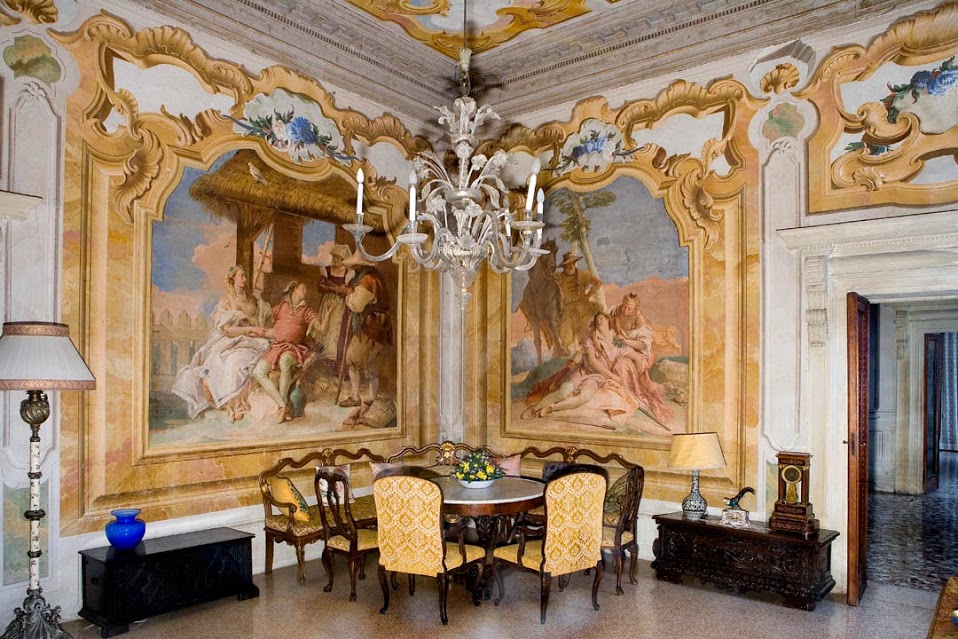
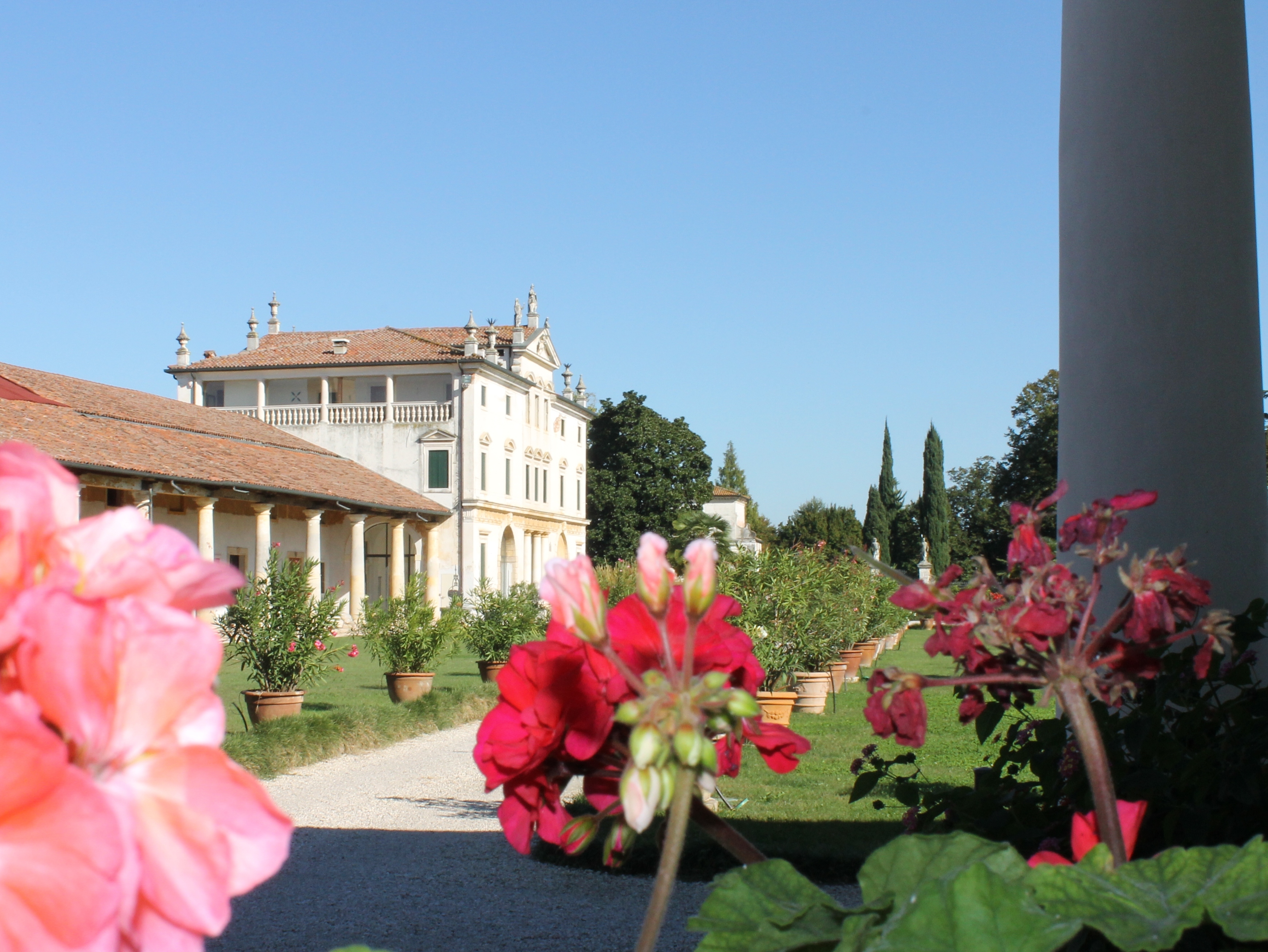
 (1565-70 - Arch. Palladio)
(1565-70 - Arch. Palladio)
 CALDOGNO
CALDOGNO
 VILLA PISANI BONETTI
VILLA PISANI BONETTI VILLA CORDELLINA LOMBARDI
VILLA CORDELLINA LOMBARDI 
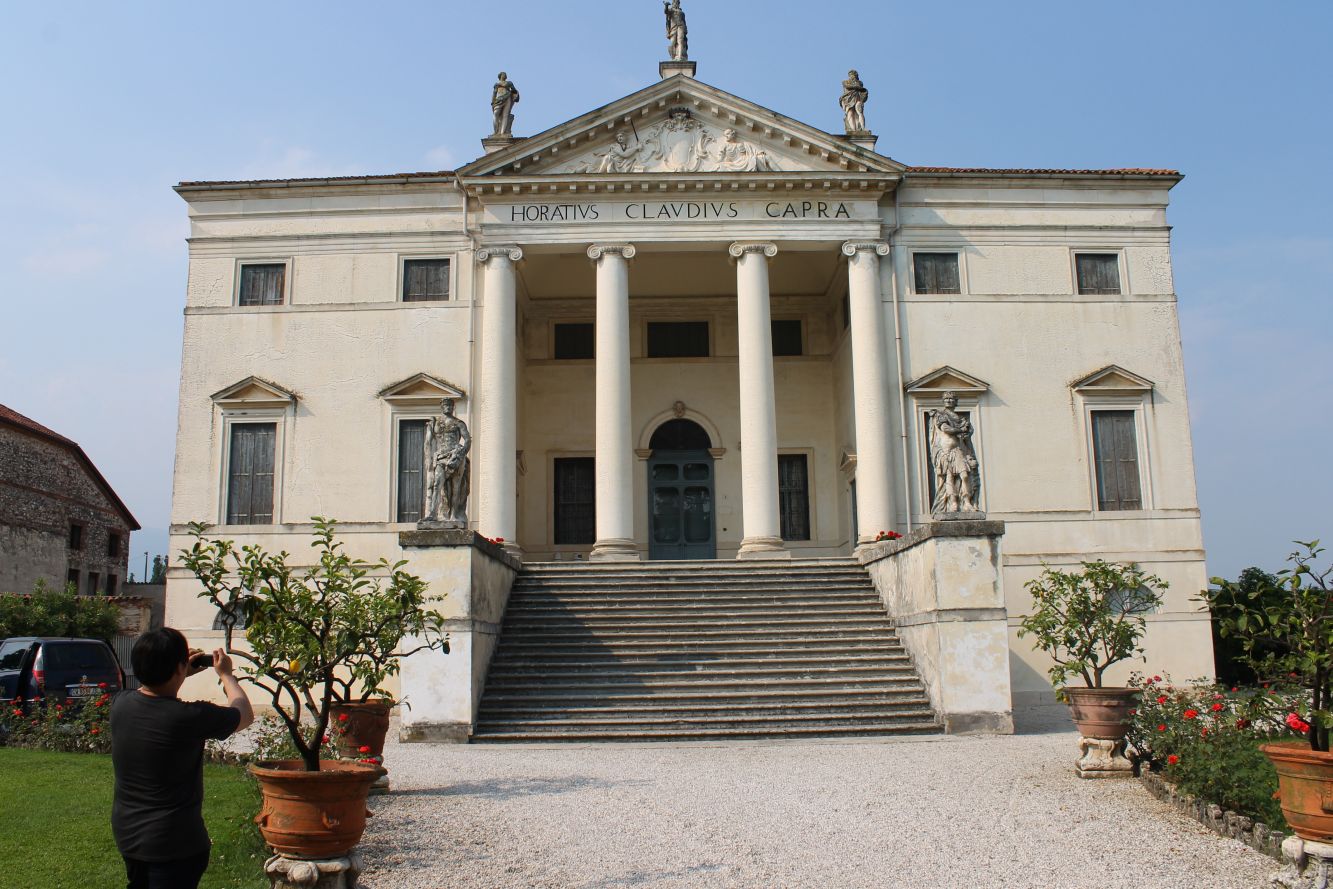


 In the mid-nineties, the UNESCO, the UN Agency for Science and Culture, enlisted Vicenza and the Palladian Villas inside its prestigious World Heritage List with the following statement:
In the mid-nineties, the UNESCO, the UN Agency for Science and Culture, enlisted Vicenza and the Palladian Villas inside its prestigious World Heritage List with the following statement: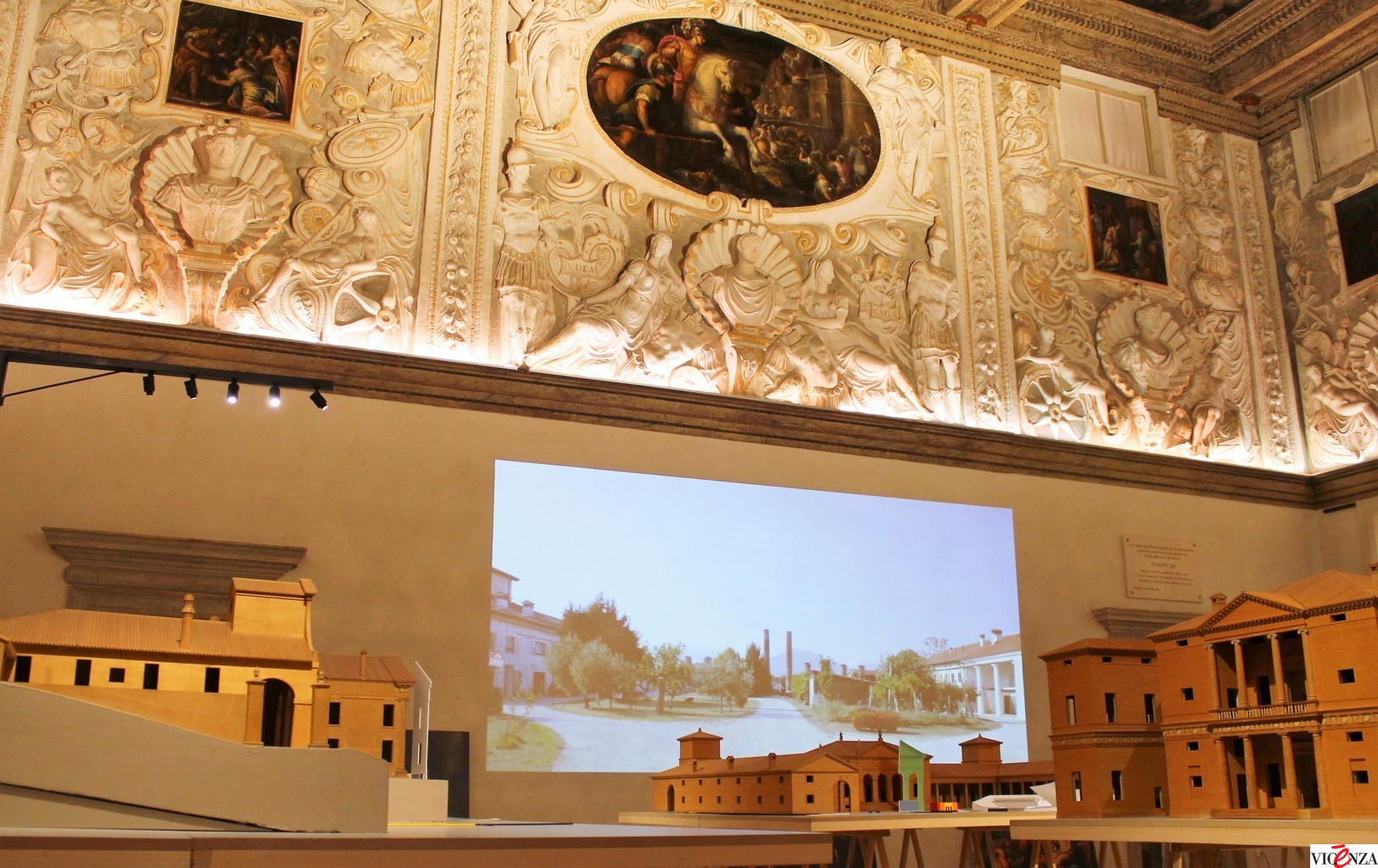
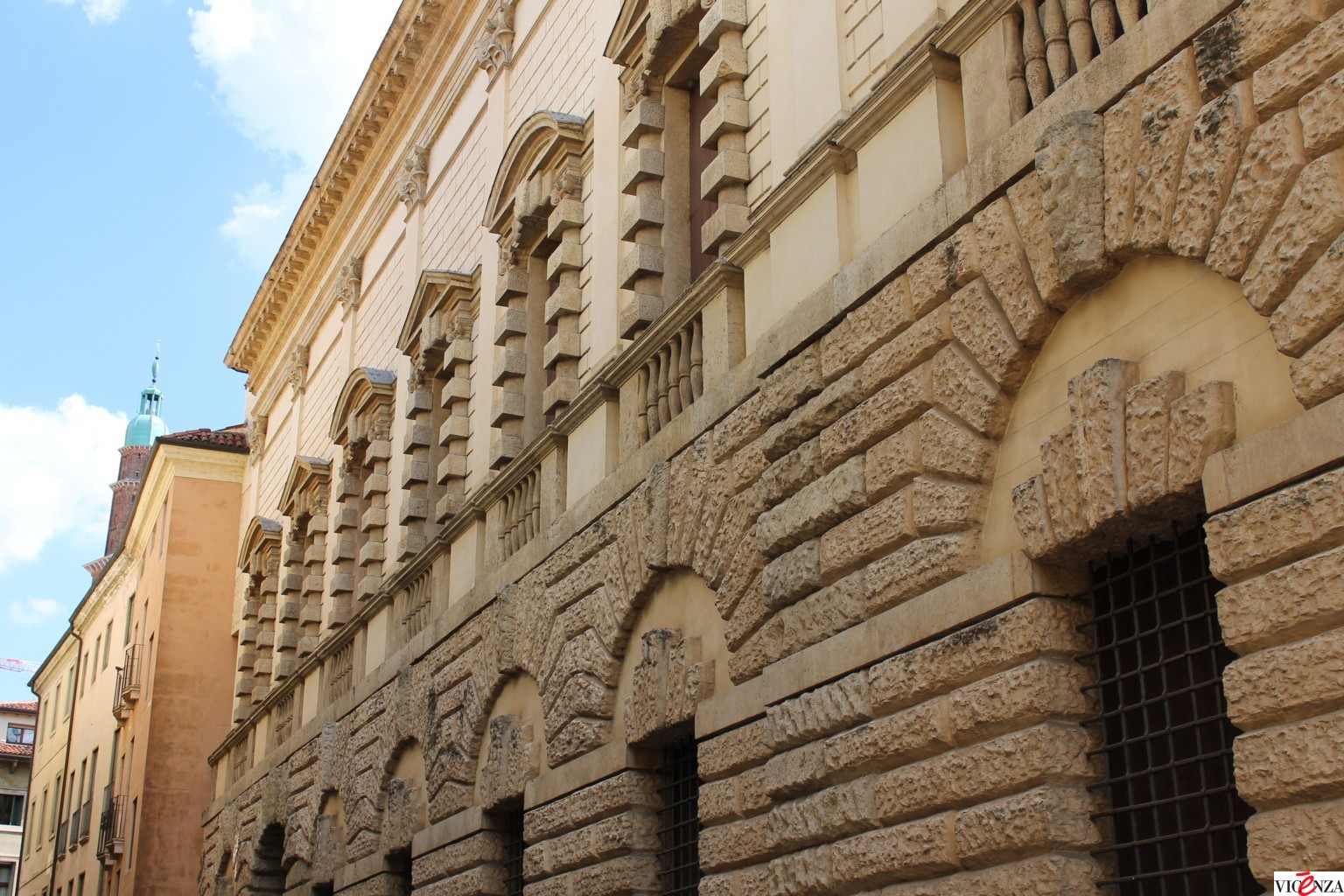
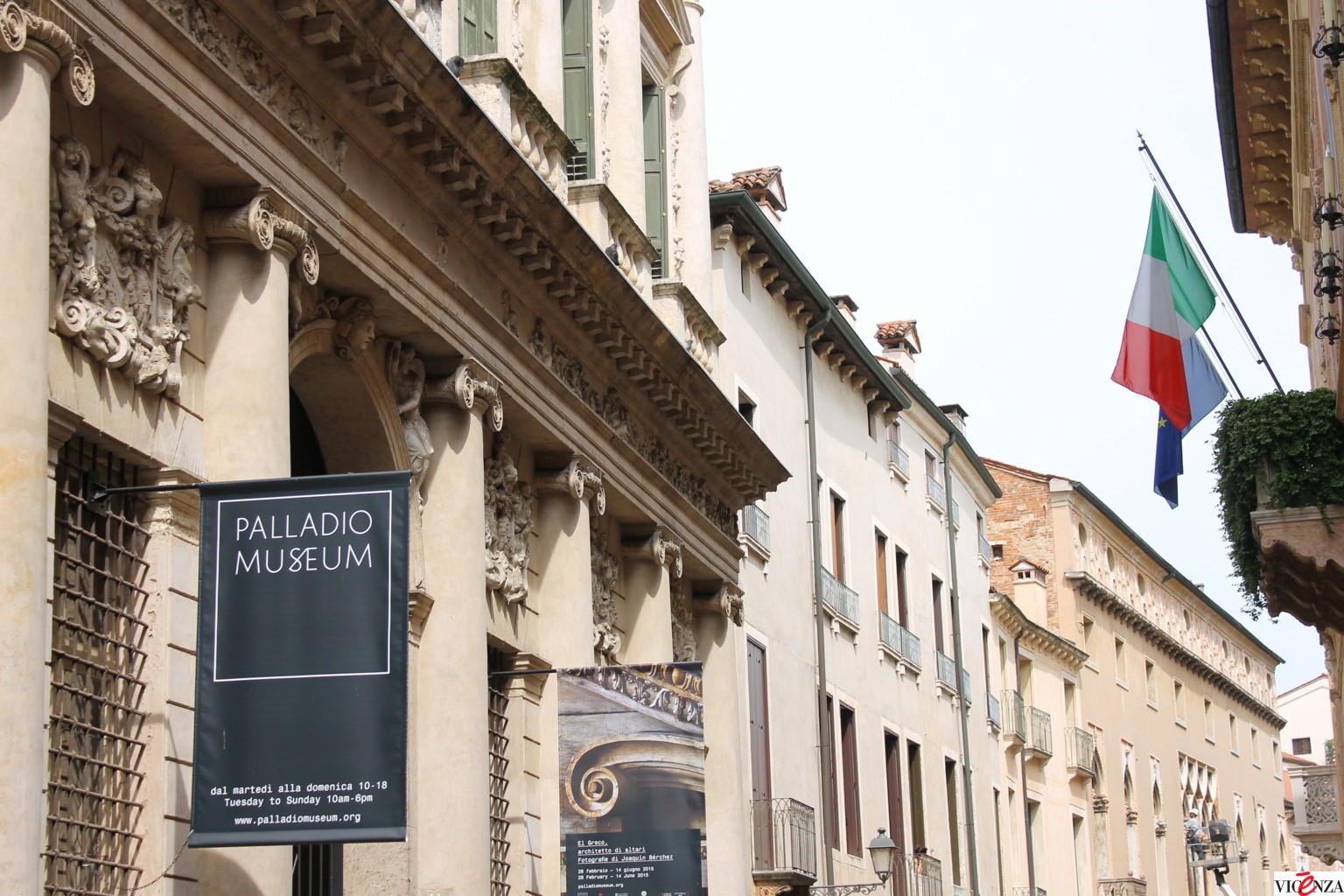
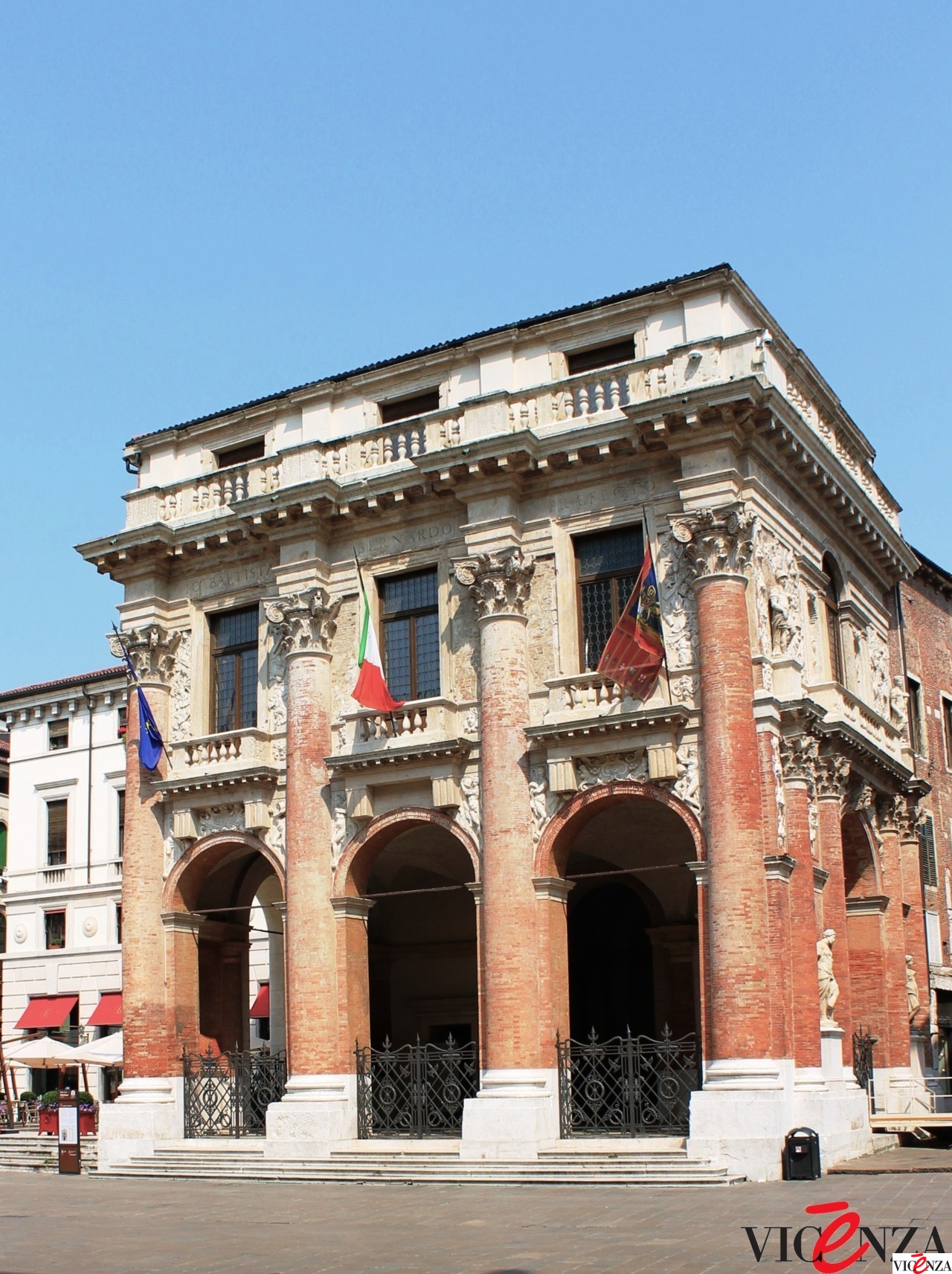
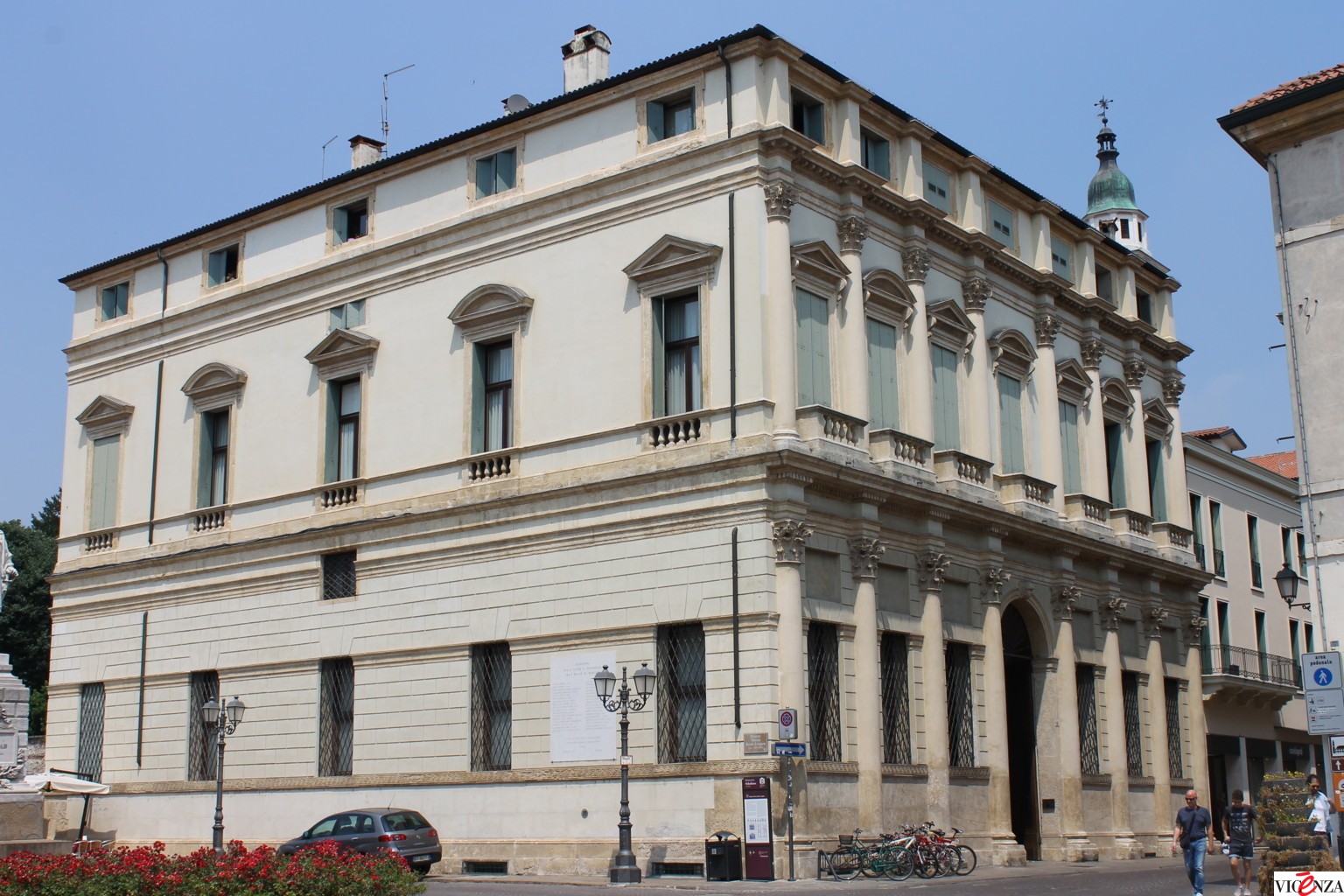

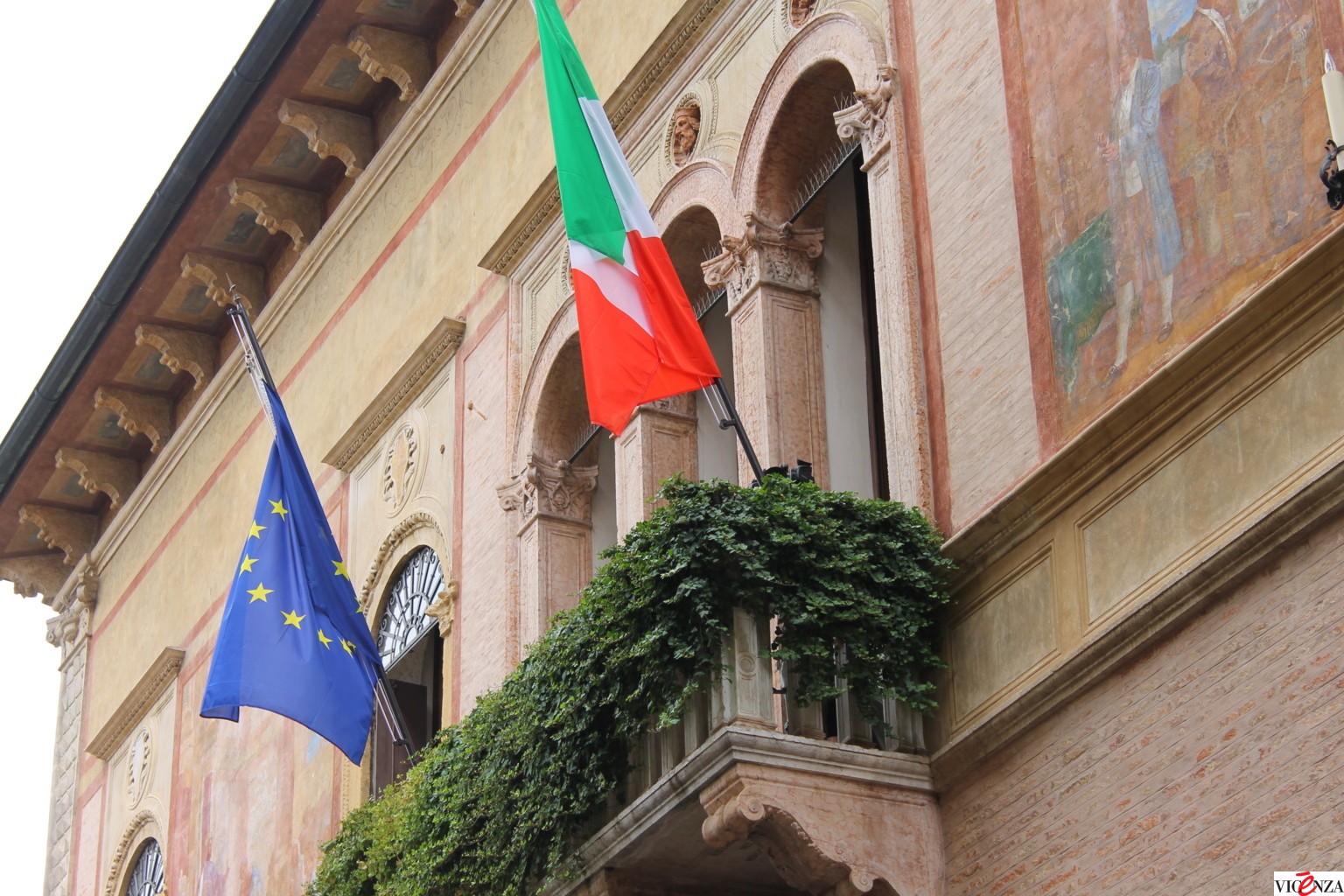
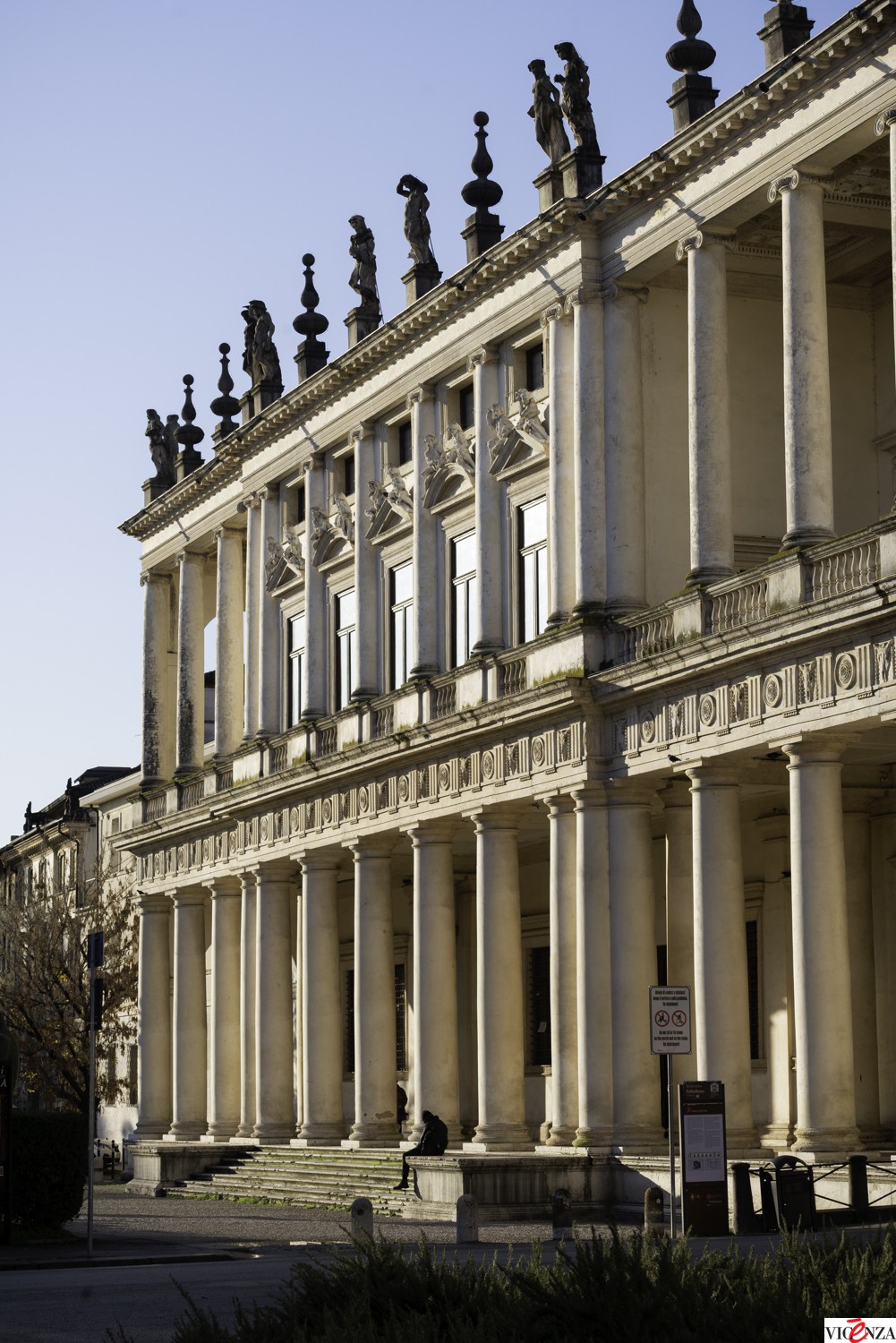
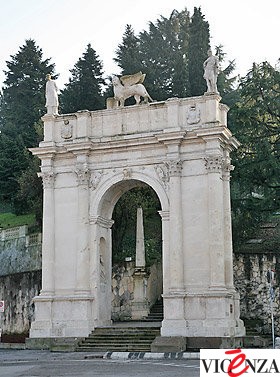
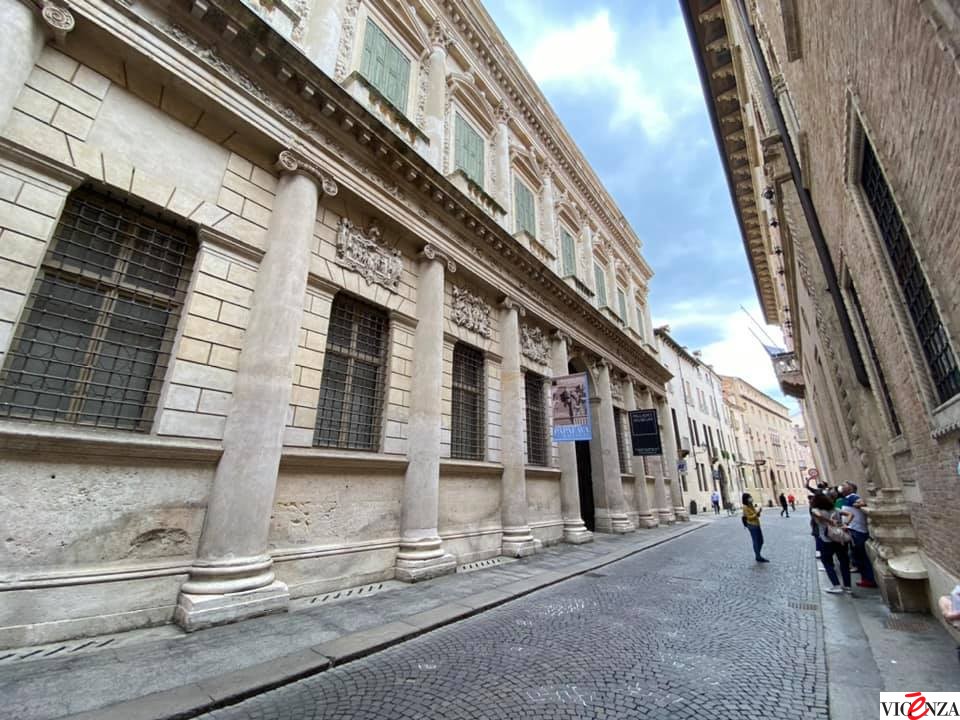
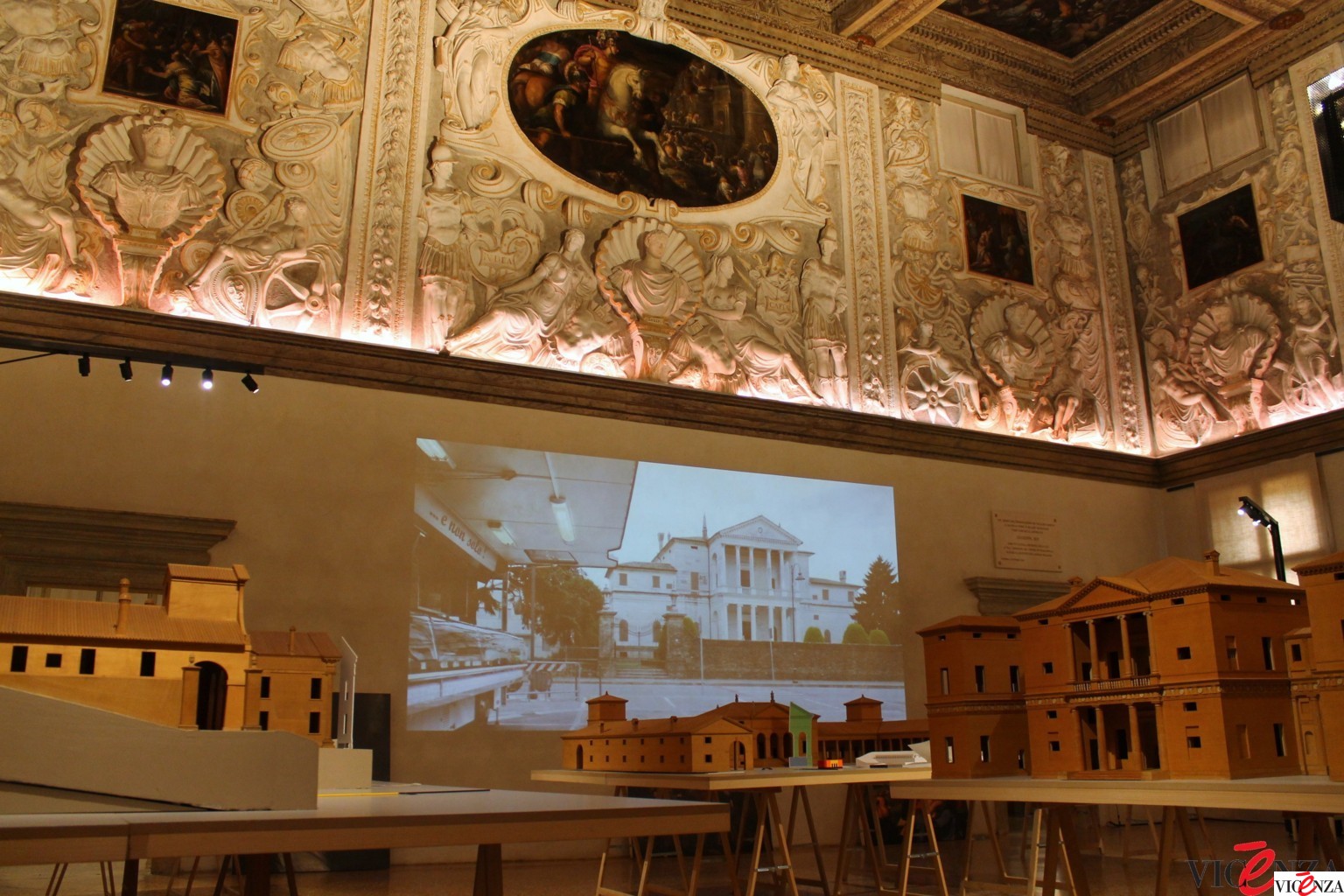

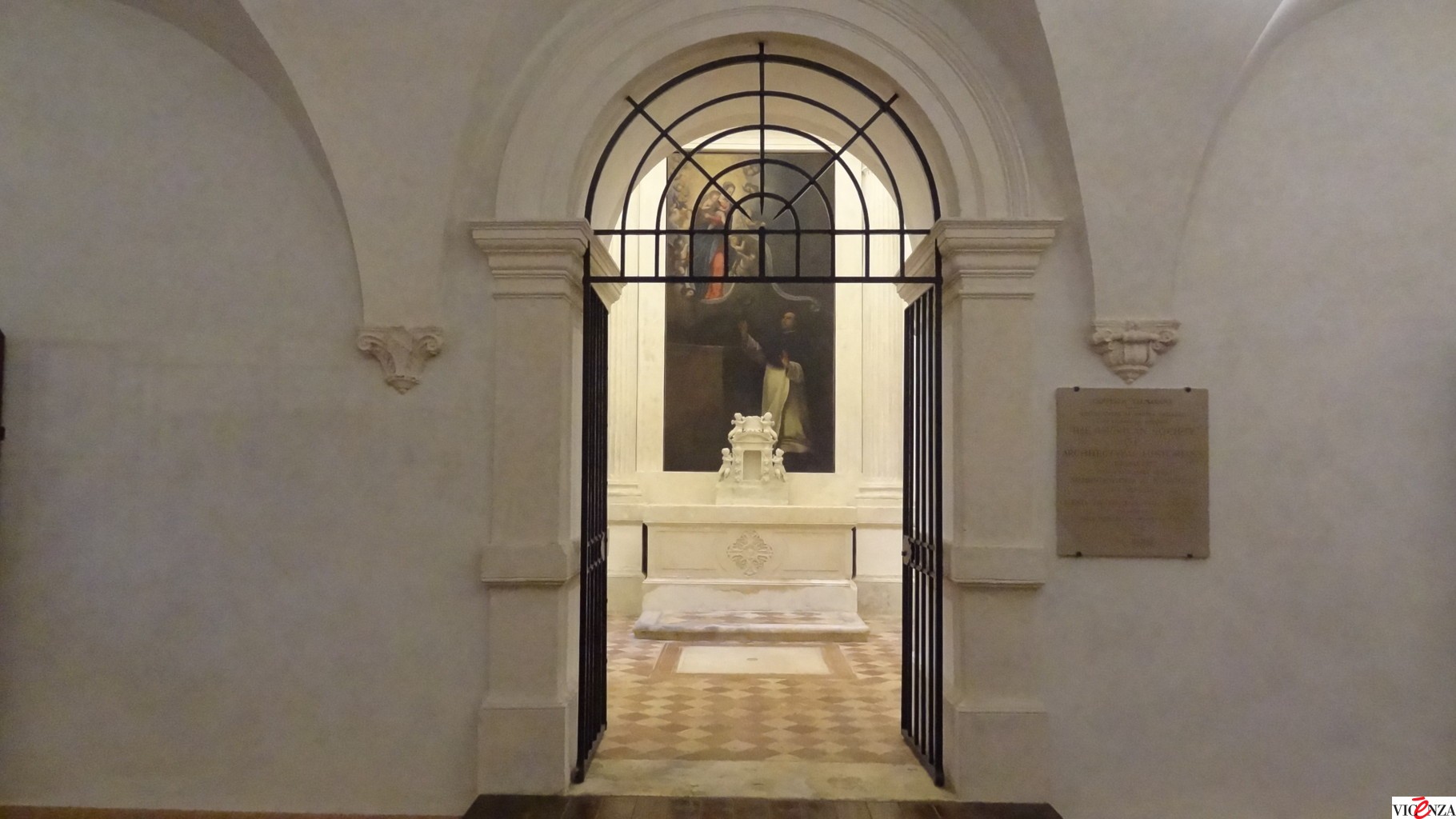
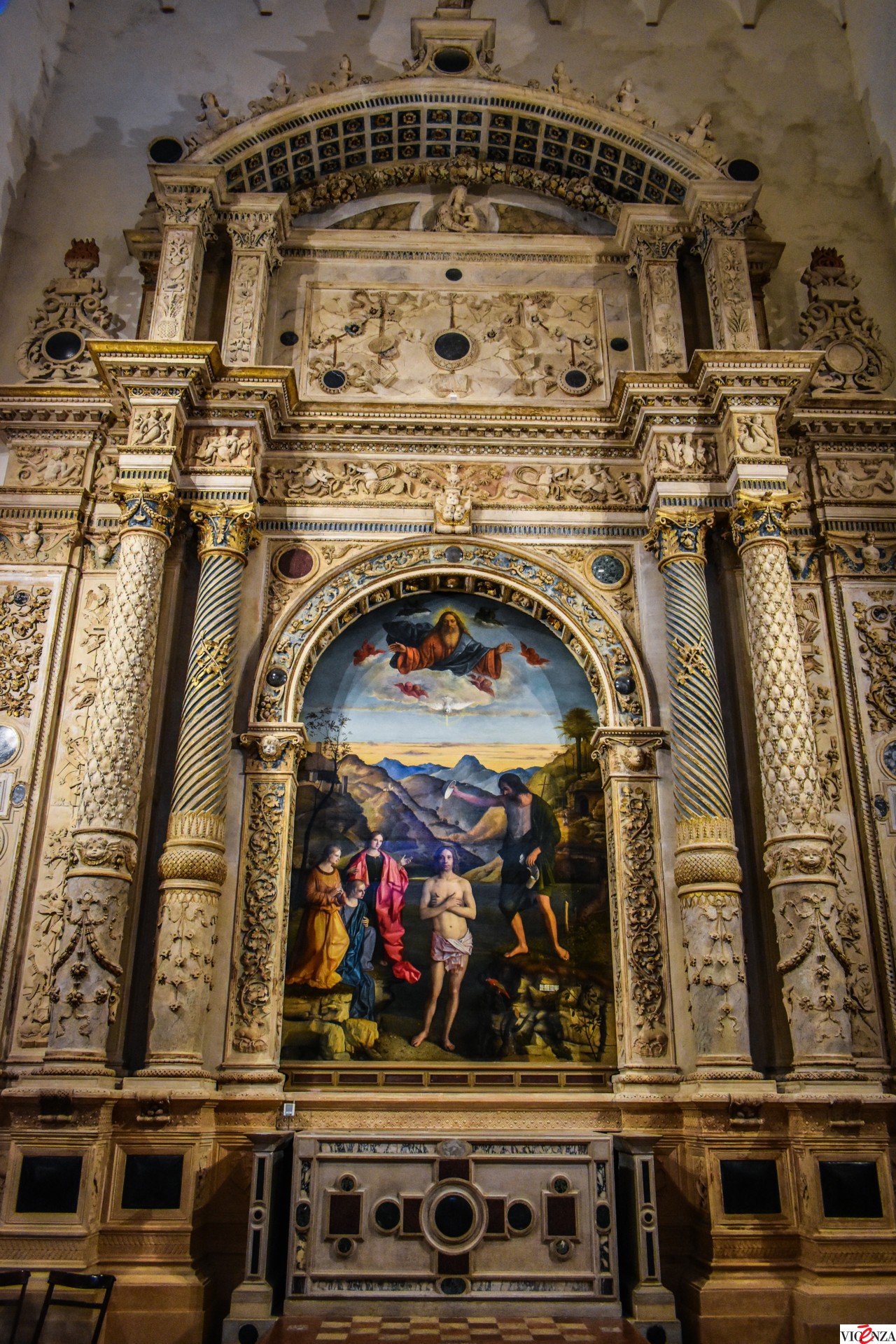
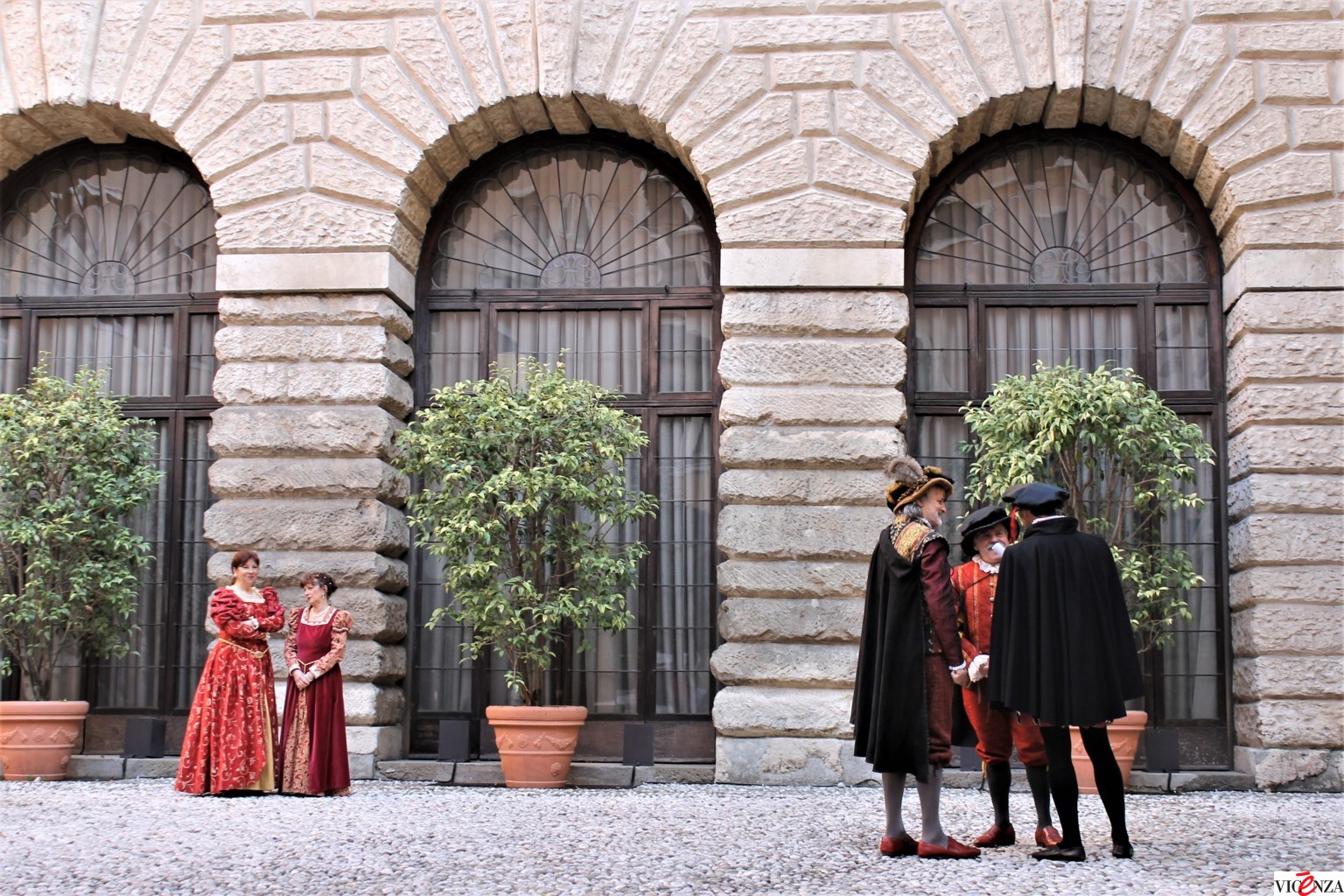
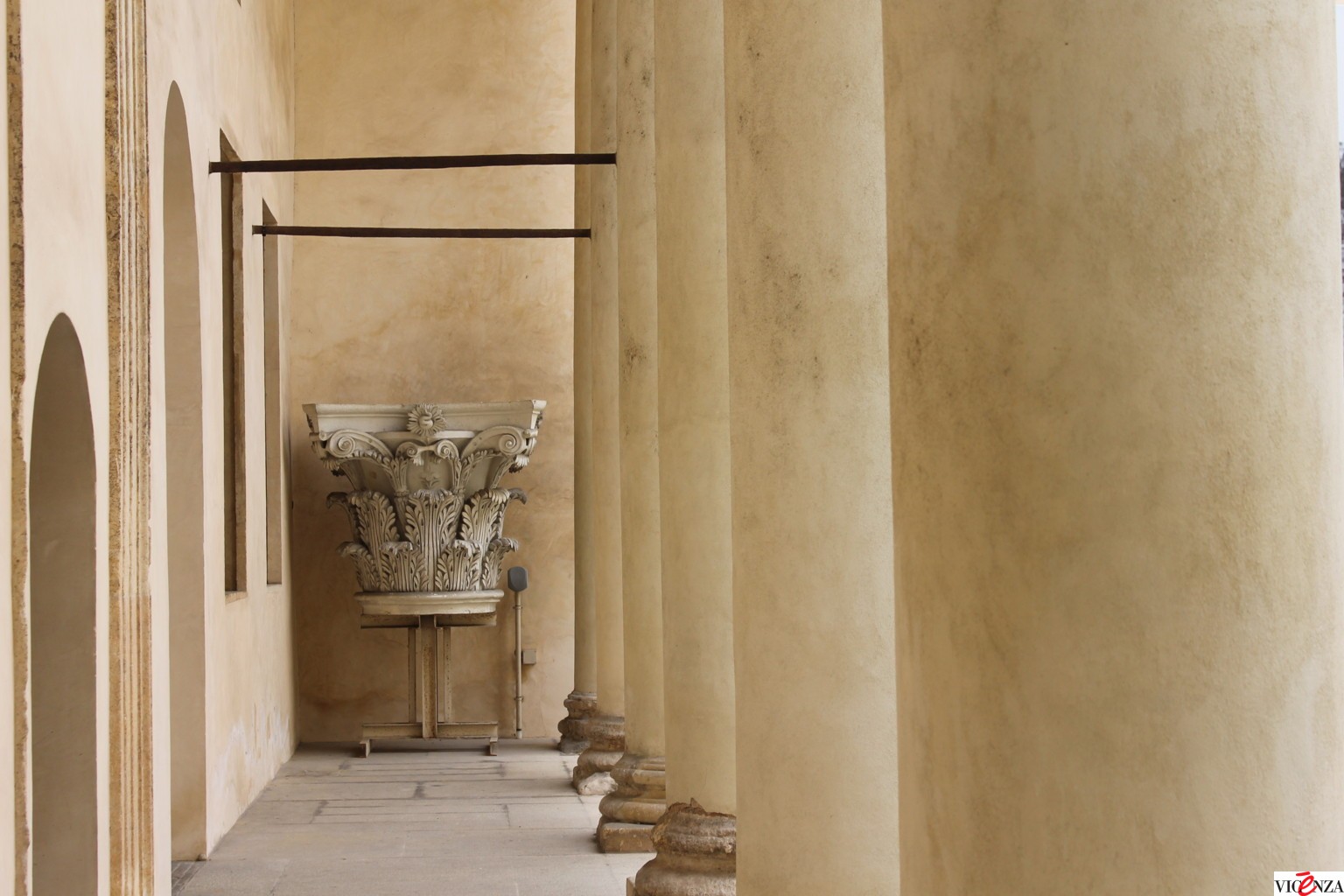
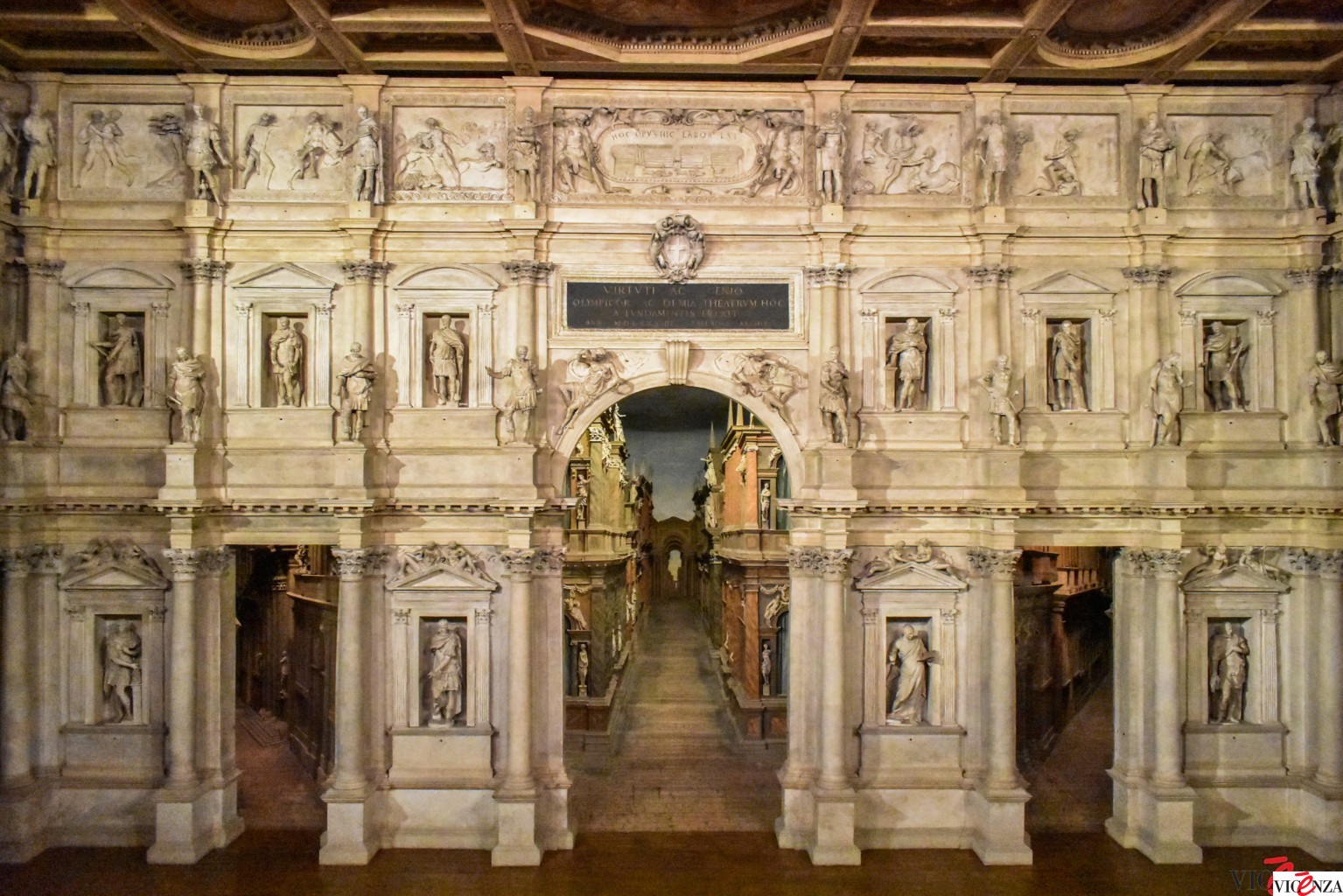
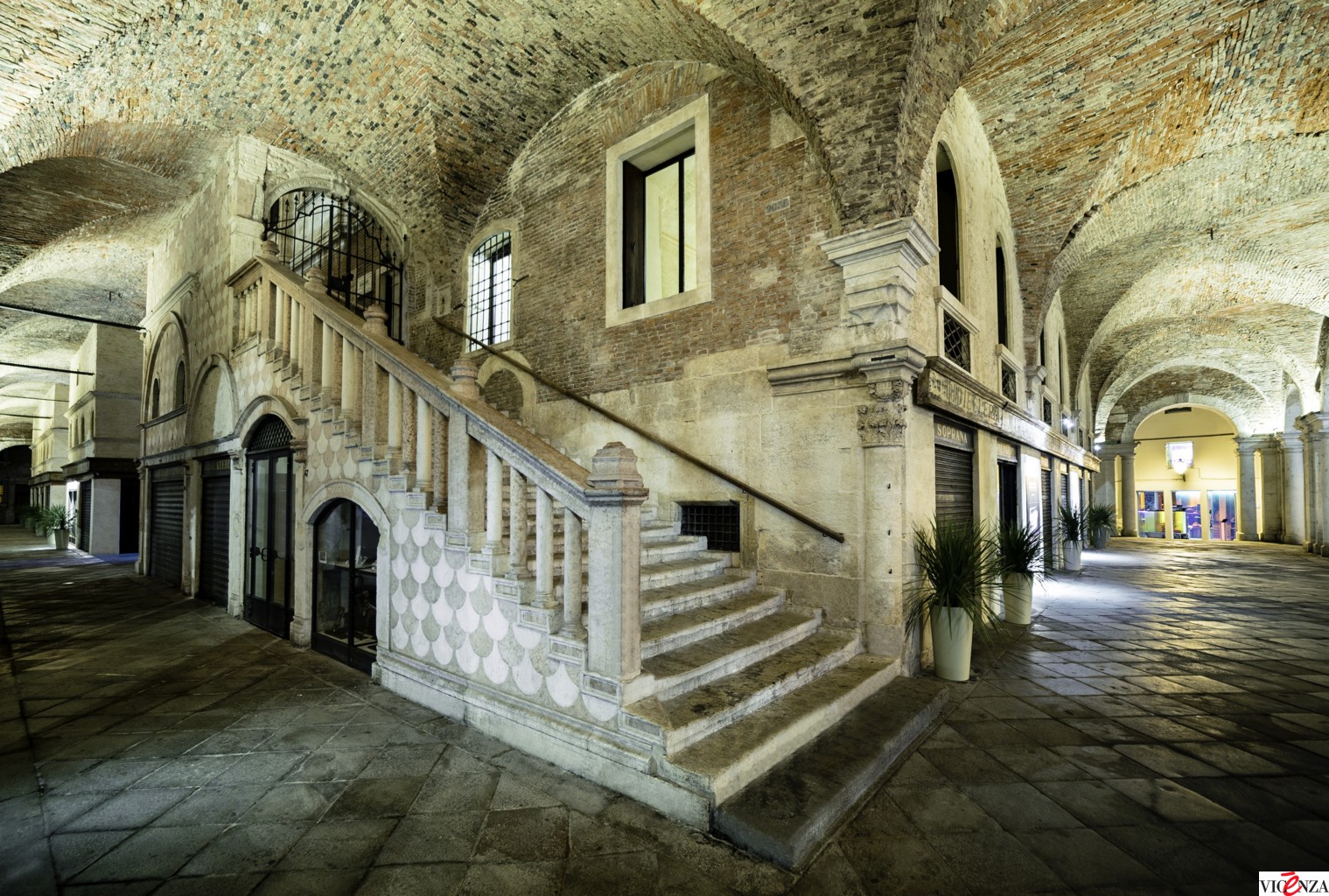
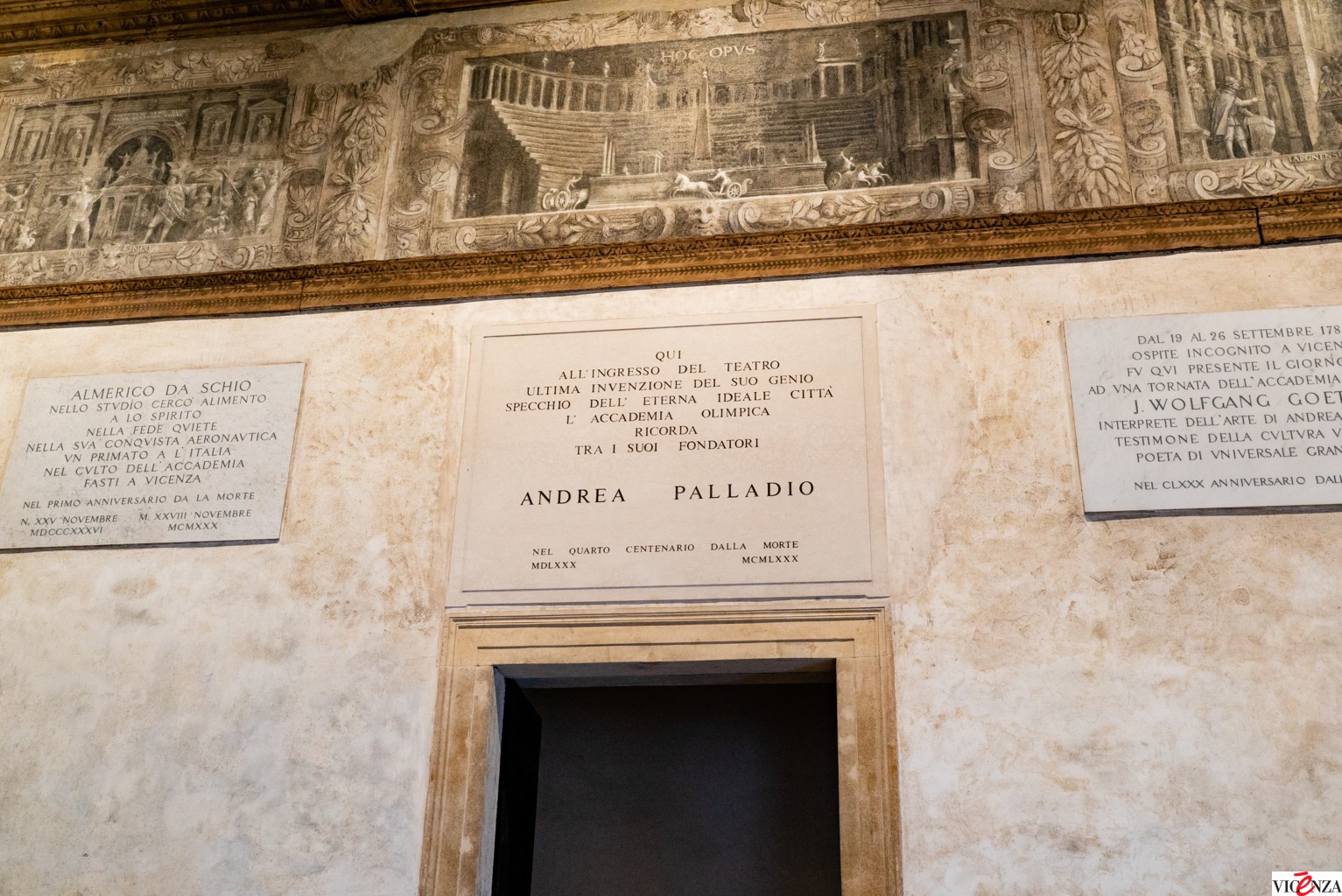
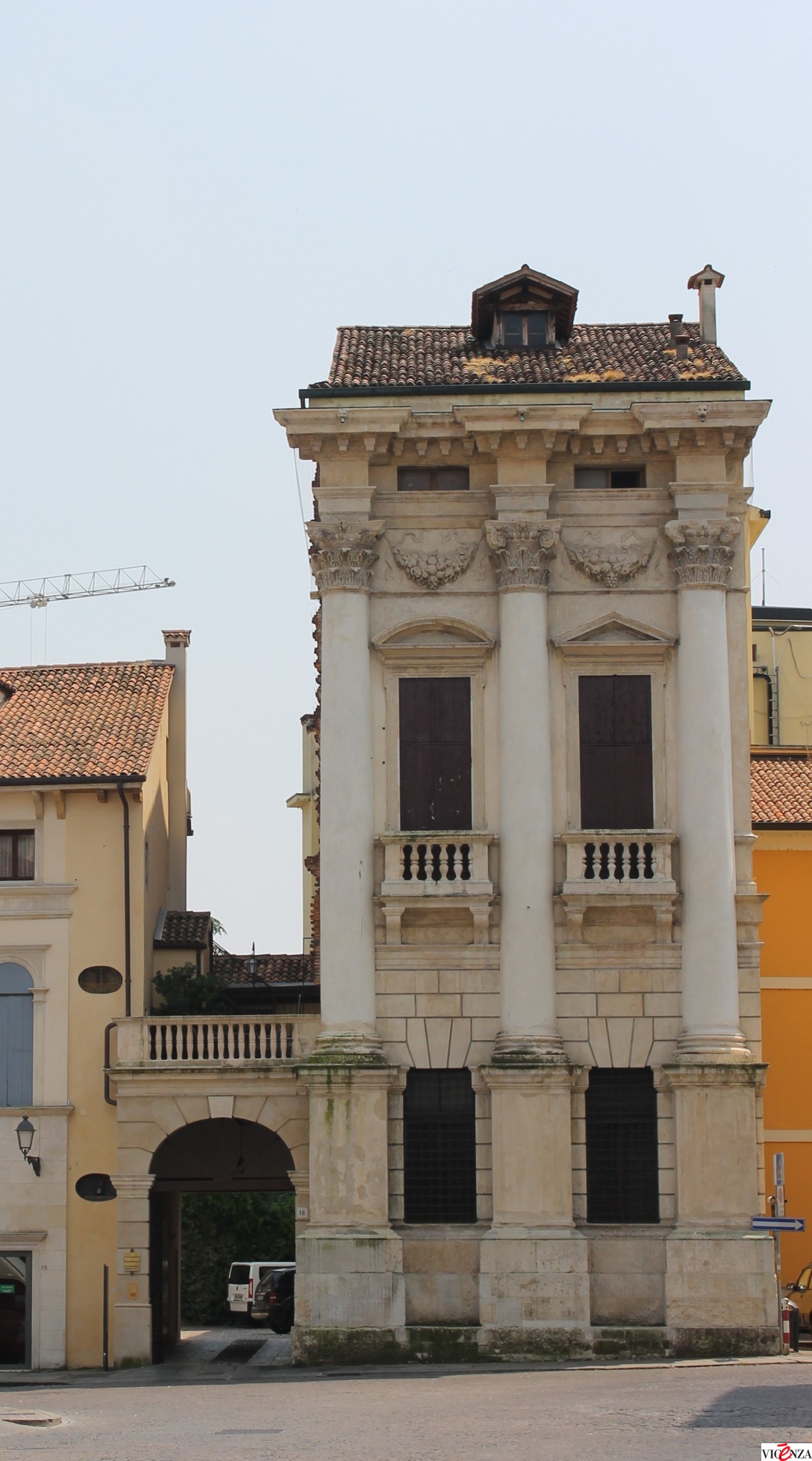
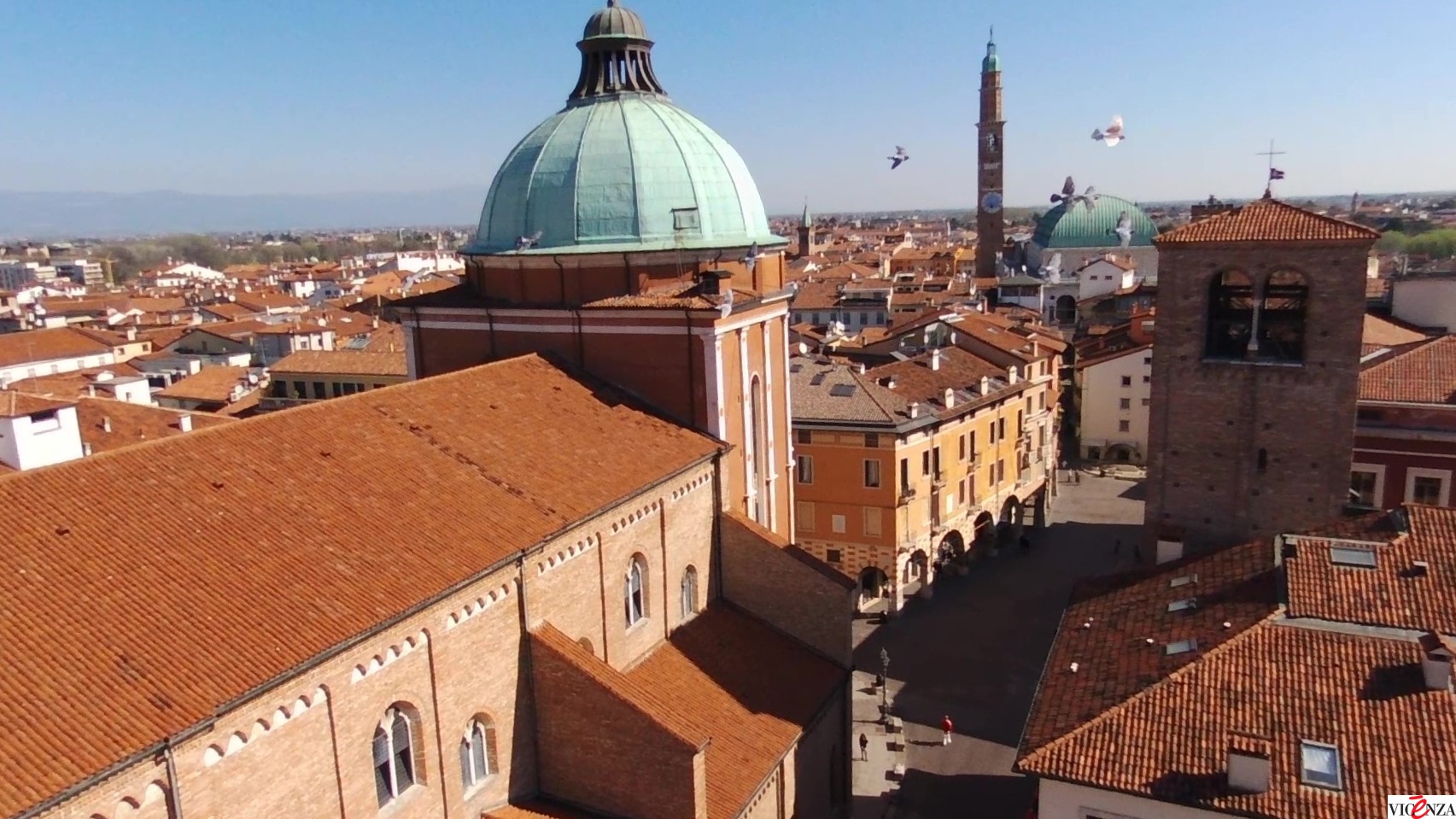
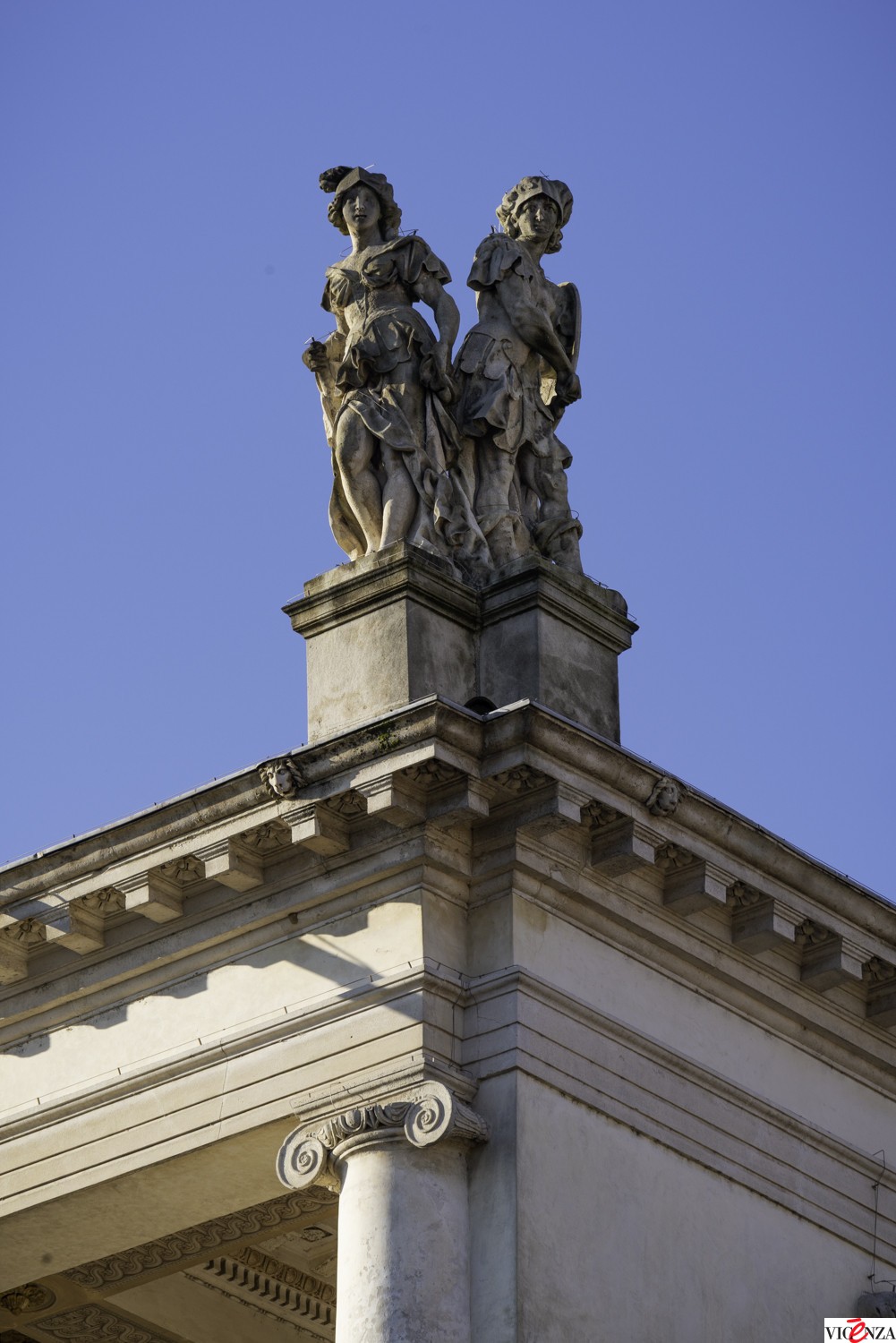
 The expression "Ville Tiepolesche" gathers those villas in which Gianbattista Tiepolo worked in Vicenza's province, leaving various frescos and paintings. In 1734 he frescoed the interiors of Villa Loschi at Biron in Monteviale; in 1743 worked at villa Cordellina. In 1757 he transformed a modest architectural construction into that famous art masterpiece which is now best known as villa Valmarana ai Nani. His artistic contribution in these villas is so remarkable that they are nowadays more famous for his frescos than for their architectural value. Tiepolo's contributions to the Palladian villas represents the changing of his age: he lived and worked between the Renaissance and the Enlightenment. According to Palladio the villa was the centre of the agricultural life; on the other hand Tiepolo's villa becomes a prestigious residence, place for freedom and liberty unlike citylife.
The expression "Ville Tiepolesche" gathers those villas in which Gianbattista Tiepolo worked in Vicenza's province, leaving various frescos and paintings. In 1734 he frescoed the interiors of Villa Loschi at Biron in Monteviale; in 1743 worked at villa Cordellina. In 1757 he transformed a modest architectural construction into that famous art masterpiece which is now best known as villa Valmarana ai Nani. His artistic contribution in these villas is so remarkable that they are nowadays more famous for his frescos than for their architectural value. Tiepolo's contributions to the Palladian villas represents the changing of his age: he lived and worked between the Renaissance and the Enlightenment. According to Palladio the villa was the centre of the agricultural life; on the other hand Tiepolo's villa becomes a prestigious residence, place for freedom and liberty unlike citylife.
 It is situated in Castelletto di Rotzo and is considered the first human village of the Altopiano with hundreds little houses, containing up till one thousand people. Open for visits.
It is situated in Castelletto di Rotzo and is considered the first human village of the Altopiano with hundreds little houses, containing up till one thousand people. Open for visits. The valley of Leogra river is an ample furrow that, from the lowland opening where the city of Schio, Italian capital of industrial heritage, is situated and proceeds in North-Westerly direction toward Pian delle Fugazze, to the base of Mount Pasubio. Schio inserts itself among the buttresses of Mount Summano and Novegno to the East and the Piccole Dolomiti, famous scenario of Word War I. The traditional agricultural and sheep-farming economy has been accompanied, since the Middle Ages, by craftmanship, evidenced by the dense net of mills, sawmills, drop-hammers and wool machinery, which sprang up along the course of the Leogra and of the Roggia Maestra (the main canal), the latter being a by-pass from the river itself constructed toward the middle of the 13th C., along the boundary of Schio with Pievebelvicino. The Roggia Maestra has determined the economic life of the population and the structure of Schio's city-centre, where there are 12 waterfalls regulated by a system of locks. The part of the roggia between Torrebelvicino and Pievebelvicino is, on the other hand, dated back to last century. The availability of hydraulic energy was fundamental for the industrial development, which occurred in the 19th century: it was, in fact a waterfall which moved the machinery through transmission chains. As in other geographical areas of Northern Italy, in the Val Leogra as well, one can observe the progressive transfer of the productive installations from the hills toward the lowland, the river always being necessary to the adoption of steam and then electricity as sources of energy. The pole of attraction not only of the valley, but of the whole Alto Vicentino (the northern territories of the Vicenza province), is Schio, which became around 1870 the capital city of the wool industry - the Manchester of Italy, or the "civitas" in the ideological conception of Alessandro Rossi based on the factory system. To testify to the ancient protoindustrial activity and the most recent industrial tradition of the val Leogra one can study various remains of different typologies from mills to sawmills, from spinning-mills to wool mills, from drop-hammers to mechanics industries, from the houses built for employees to the working class districts, etc. But dominating over everithing else, together the towering brick factory chimineys, is the Fabbrica Alta (high factory), real "cathedral to labour", eloquent sign of the European dimension of the Schio industrial phenomenon. To explore these testimonies means to reconstruct the net of relationships and of objects which sprang up around the workshops, the behaviours, the ways of being, the ideas that have gave to one of the most interesting chapters of the industrial civilisation of the Veneto region.
The valley of Leogra river is an ample furrow that, from the lowland opening where the city of Schio, Italian capital of industrial heritage, is situated and proceeds in North-Westerly direction toward Pian delle Fugazze, to the base of Mount Pasubio. Schio inserts itself among the buttresses of Mount Summano and Novegno to the East and the Piccole Dolomiti, famous scenario of Word War I. The traditional agricultural and sheep-farming economy has been accompanied, since the Middle Ages, by craftmanship, evidenced by the dense net of mills, sawmills, drop-hammers and wool machinery, which sprang up along the course of the Leogra and of the Roggia Maestra (the main canal), the latter being a by-pass from the river itself constructed toward the middle of the 13th C., along the boundary of Schio with Pievebelvicino. The Roggia Maestra has determined the economic life of the population and the structure of Schio's city-centre, where there are 12 waterfalls regulated by a system of locks. The part of the roggia between Torrebelvicino and Pievebelvicino is, on the other hand, dated back to last century. The availability of hydraulic energy was fundamental for the industrial development, which occurred in the 19th century: it was, in fact a waterfall which moved the machinery through transmission chains. As in other geographical areas of Northern Italy, in the Val Leogra as well, one can observe the progressive transfer of the productive installations from the hills toward the lowland, the river always being necessary to the adoption of steam and then electricity as sources of energy. The pole of attraction not only of the valley, but of the whole Alto Vicentino (the northern territories of the Vicenza province), is Schio, which became around 1870 the capital city of the wool industry - the Manchester of Italy, or the "civitas" in the ideological conception of Alessandro Rossi based on the factory system. To testify to the ancient protoindustrial activity and the most recent industrial tradition of the val Leogra one can study various remains of different typologies from mills to sawmills, from spinning-mills to wool mills, from drop-hammers to mechanics industries, from the houses built for employees to the working class districts, etc. But dominating over everithing else, together the towering brick factory chimineys, is the Fabbrica Alta (high factory), real "cathedral to labour", eloquent sign of the European dimension of the Schio industrial phenomenon. To explore these testimonies means to reconstruct the net of relationships and of objects which sprang up around the workshops, the behaviours, the ways of being, the ideas that have gave to one of the most interesting chapters of the industrial civilisation of the Veneto region. …. In fact, Vicenza’s doesn’t represent just an economical miracle, but also a cultural one. A miracle of writing and sculture, which can just be sketched by these pages: they suggest itineraries, sometimes with the effort of intellectuals and renowned people, who were fascinated by this land, and have kept some surprising aspects of it. With their effort we hope to amaze even the nowadays visitor, so that, after coming back home from his Grand Tour in Vicenza’s lands, he would feel pushed to pick up his old edition of Meneghello’s, Piovene’s, Parise’s or Fogazzaro’s operas, ended up somewhere on his bookshelves.
…. In fact, Vicenza’s doesn’t represent just an economical miracle, but also a cultural one. A miracle of writing and sculture, which can just be sketched by these pages: they suggest itineraries, sometimes with the effort of intellectuals and renowned people, who were fascinated by this land, and have kept some surprising aspects of it. With their effort we hope to amaze even the nowadays visitor, so that, after coming back home from his Grand Tour in Vicenza’s lands, he would feel pushed to pick up his old edition of Meneghello’s, Piovene’s, Parise’s or Fogazzaro’s operas, ended up somewhere on his bookshelves.
